#1956 Chevrolet Custom Sedan
Photo

New Post has been published on https://fastmusclecar.com/the-ford-fairlane/best-muscle-cars/
The Ford Fairlane
The Ford Fairlane is one of the less obvious muscle cars sold between 1955 and 1970 in North America. It is well-known for its variety of body styles, including two-door and four-door sedans, two-door and four-door hardtops, station wagons, and both traditional and retractable-hardtop convertibles. The Ford Fairlane was the predecessor to the Crown Victoria and 500 nameplates which later became stand-alone full-size models. From a muscle car perspective, the 427cu(7.0 L) Cobra V8 from 196-67 and the 428cu(7.0 L) FE V8 of 1969 are the standout versions. In South America, the sixth generation of Ford Fairlane was marketed until 1981.
Along with introducing the Ford Fairlane, Ford also introduced the 1955 model year with a full-size offering. The Ford Fairlane had six different body styles available, including the Crown Victoria with a tinted transparent plastic roof, the regular Fairline with stainless steel trim, a convertible Sunliner, the Victoria hardtop coupe, and a traditional sedan. Power options at this time included a 223 cu in I6 engine and a 272 cu in V8 engine.
In 1956, the Fairlane was given new and slimmer roofline, with a one-year-only two-door station wagon, the 1956 Squire, offered to compete against the Chevrolet Nomad. This same year, a safety package was also introduced. For the 1957 to 1959 model years, the Fairlane 500 was added to the Fairlane lineup while other new features included new trim, the 292 cu in V8 Y-block called the Thunderbird V-8, and the 302 V8 option was expanded with a 332 and 352 cu in V8. These changes were popular with customers who, for the first time since 1935, outsold the Chevrolet in 1957.
The Ford Fairlane was also the first vehicle to feature the push-button cruise control mechanism, an innovation that was eventually adopted by many competing car manufacturers. In addition, Ford introduced a new two-speed Ford-O-Matic transmission in 1958, giving drivers the ability to switch between low and high gear without the need for a clutch pedal.
The Sixties saw even more improvements and features added to the Ford Fairlane, including a chrome grille and a reshaped hood. The Fairlane also received an upgraded chassis, power steering, and body insulation to reduce noise levels. In 1967, Ford completely redesigned the Fairlane and included a much wider track and larger wheelbase. The new Fairlane also featured a new suspension system, variable ratio power steering, and a slew of other comfort and convenience features.
In 1968, the Ford Fairlane was given a restyle and in 1969, the Fairlane was completely redesigned again with an all-new body style. This last generation of the Ford Fairlane was sold until 1970 and came equipped with a powerful 429 cu in V8 engine, making the Fairlane very popular with muscle car enthusiasts.
In the years since production of the Ford Fairlane stopped in 1970, the car has gained in popularity with collectors and classic car fans alike. The Ford Fairlane is now seen as a classic American car, and its sleek and stylish design makes it a favorite among collectors. Today, Ford Fairlanes from all periods of production can still be found on the used car market with various price points depending on rarity and options.
The Ford Fairlane is also notable for being the first car to feature the now-popular “shaker” hood scoop. This feature, which was originally designed for improved engine cooling, is now a popular styling element with classic car enthusiasts. The Ford Fairlane’s shaker hood is one of the most iconic features of the car, and its popularity continues to this day.
1 note
·
View note
Text
BEHIND THE WHEEL!
Lucy & Cars ~ Part Two

In the 1960s America took to the open road. Everyone owned a car - and Lucy Carmichael was no exception. In Danfield and Los Angeles “The Lucy Show” was motorized!

“Lucy Buys a Sheep” (1962) ~ When Lucy goes to pick out a sheep to act as a lawn mower, she drives a 1949 Packard Super Deluxe 8 convertible. Packard started making automobiles in 1899 and went out of business in 1958, four years before the series premiered. Future episodes indicate that Lucy doesn’t own a car, so the Packard may belong to Viv.

“Lucy and Viv Are Volunteer Firemen” (1963) ~ As the Chief, Lucy gets to drive the fire truck! This is a Moreland Truck, a company based in Los Angeles.
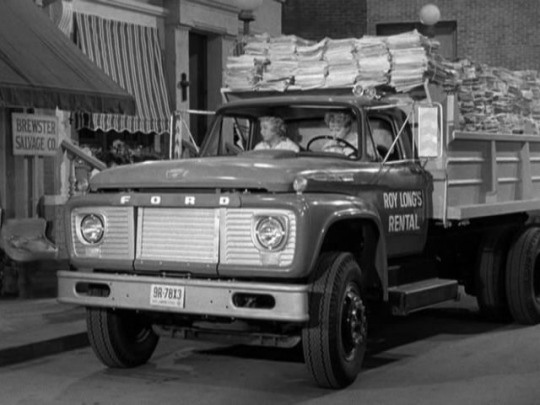
“Lucy Drives a Dump Truck” (1963) ~ The title tells it! Lucy and Viv drive a 1956 Ford F-Series dump truck to deliver recycled newspapers for cash. The truck has 'Roy Long's Rental' written on the doors. In reality, Roy Long was Desilu's construction superintendent. This is a huge production for the series, using more than a dozen extras, 160,000 newspapers, an enormous sound stage dressed as a city street, and six vehicles.

Parked on the street is a 1961 Chevrolet Apache light-duty truck with a Fleetside bed option. [More about motorcyles in a future blog.]
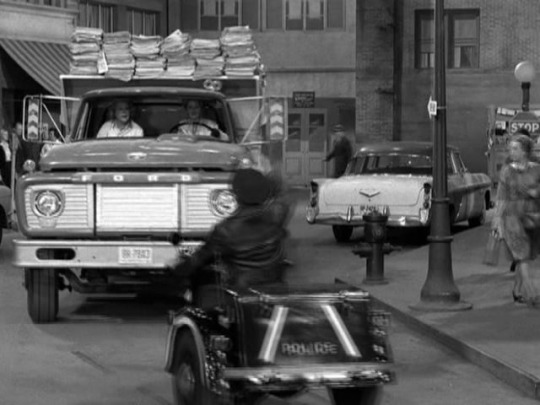
The dump truck passes a 1956 De Soto Fireflite Four-Door Sedan.
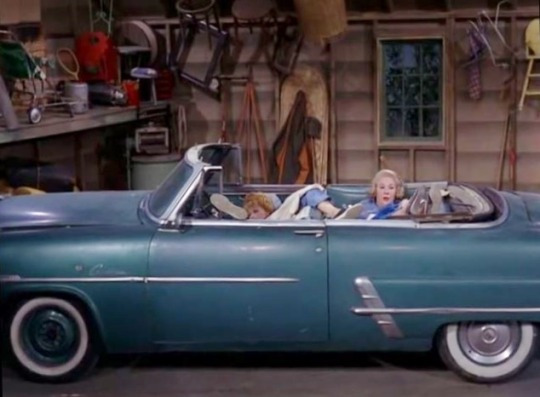
“Lucy Decides to Redecorate” (1963) ~ When they redecorate the house, Lucy and Viv must sleep in the car! Viv's car is a 1953 Ford Crestline Sunliner convertible. This is the first time we have seen inside the Carmichael's garage.
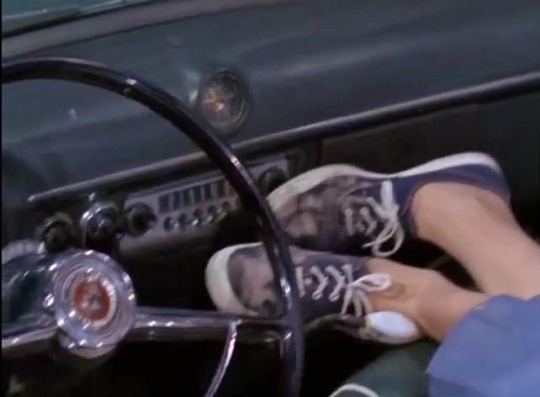
A close-up of the interior of the vehicle and Lucy’s feet!

In her sleep, Lucy’s foot hits the gear shift and the car crashes through the living room wall.

“Lucy, the Camp Cook” (1964) ~ Mr. Mooney drives to the camp in a 1964 Ford Falcon Sprint. The Sprint was overshadowed by the Mustang and was discontinued after 1965. When the car runs out of gas, they must hitchhike.
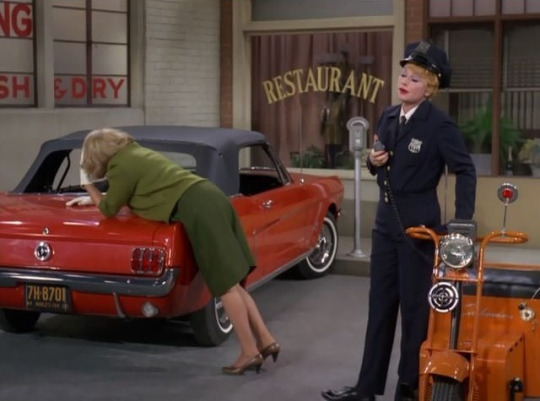
“Lucy the Meter Maid” (1964) ~ Is another exterior street set featuring lots of vehicles. A 1965 Ford Mustang may also be the same car used in an October 1964 episode of “The Dick Van Dyke Show,” also filmed on the Desilu lot.
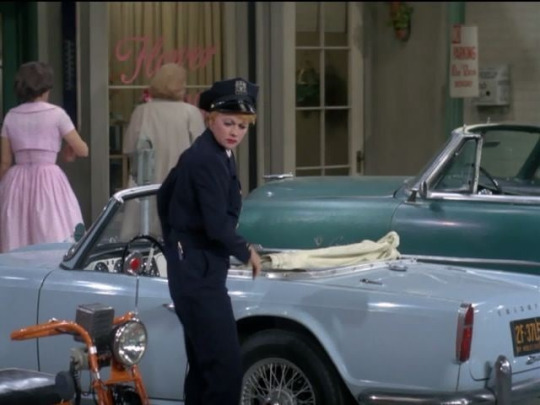
Lucy tickets a 1962 Triumph TR4. In court, the Judge admits to owning a “1964 blue convertible” which may be a reference to this car, despite the difference in the actual model year. The license plate is a 1964 NY World’s Fair commemorative plate. Behind it is the 1953 Ford Crestline Sunliner previously seen in “Lucy Decides to Redecorate”.

“Lucy Makes a Pinch” (1965) ~ On a stake-out, Lucy and Detective Baker park on Lover’s Lane in a 1964 Lincoln Continental convertible.
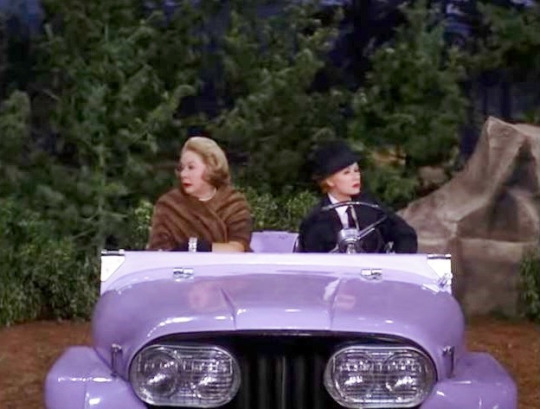
When Lucy and Viv are on their own stake out, they are sitting in a customized Jeep CJ-5. It is never stated where or how they acquired a lavender jeep!

“Lucy at Marineland” (1965) ~ When the show relocates to California, the first episode opens with location footage of Marineland in Rancho Palos Verdes, California . Mr. Mooney agrees to leave work at the bank and drive Lucy and Jerry to Marineland in his light colored Ford Falcon convertible.
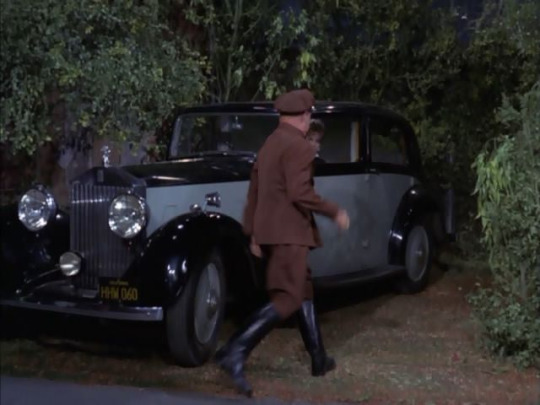
“Lucy and the Undercover Agent” (1965) ~ Lucy, Mr. Mooney, and the Countess go undercover. Mr. Mooney is the chauffeur of a Rolls-Royce 25/30 HP Park Ward swept-tail saloon car.
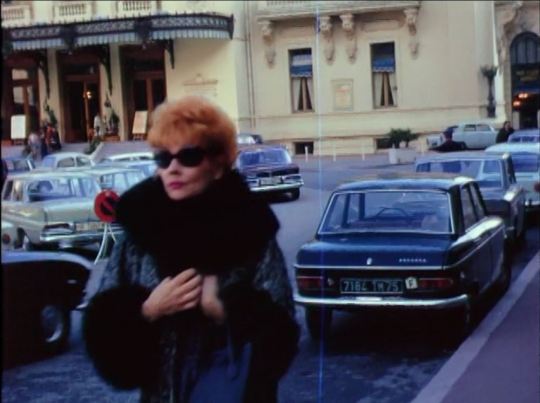
In 1965, Lucille Ball and her husband Gary Morton filmed a home movie while vacationing in Monte Carlo. The film takes place on the streets and features many vehicles.

“Lucy and the Submarine” (1966) ~ Before sneaking onto the submarine, Lucy hides out in a parked Laundry van.

“Lucy and the Ring-A-Ding Ring” (1966) ~ In this episode Mr. Mooney drives a red Volkswagen convertible bug, a somewhat unusual choice for a middle-aged banker during in the mid-1960s.
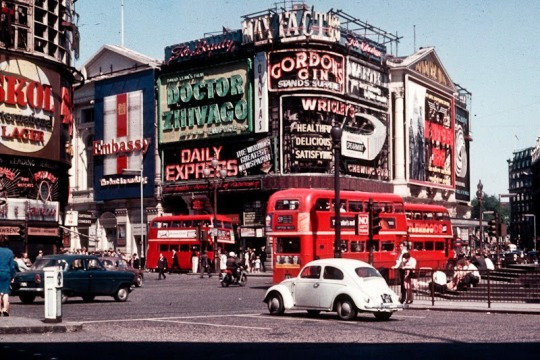
“Lucy in London” (1966) ~ The special was shot on location. Footage of Picadilly circus includes many vehicles, including a white VW Beetle.

“Lucy Puts Main Street on the Map” (1966) ~ A news crew operates out of a blue hatchback station wagon. The camera is mounted on the roof.

“Lucy Gets Involved” (1968) ~ Lucy moonlights as a carhop at a drive-in burger joint. The episode features the light blue 1962 Triumph TR4 convertible previously seen in “Lucy, the Meter Maid”.

The scenes feature a blue Ford Convertible, a vintage 1920s Roadster, a blue Sports Car, a red VW Beetle with Moon Roof, and a Police Car.
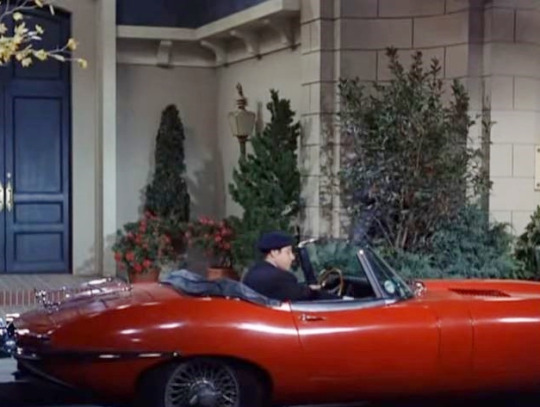
“Lucy and the Stolen Stole” (1968) ~ Buddy Hackett plays a conman who drives a little red sportscar.
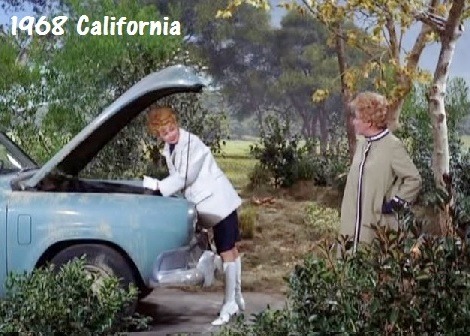
“Lucy and the Lost Star” (1968) ~ Before arriving at Joan Crawford’s mansion, Lucy and Viv’s car breaks down in the middle of nowhere.
#The Lucy Show#Lucille Ball#Gale Gordon#Vivian Vance#cars#trucks#automobiles#tv#Lucy#Desilu#vehicles#car
0 notes
Text
1955 ford engine serial number location

1955 FORD ENGINE SERIAL NUMBER LOCATION DRIVER
1955 FORD ENGINE SERIAL NUMBER LOCATION SERIES
There were new convenience options, such as a new air-conditioner system, a new heater, and a nine-tube signal-seeking radio. The Parklane, a Fairlane trimmed Tudor station wagon, was added to compete with the Chevrolet Nomad. A new addition at midyear was the "Town Victoria" 4-door hardtop model which, along with the new Customline Victoria 2-door hardtop, were meant to compete with the Chevrolet Bel Air and Plymouth Belvedere. The Crown Victoria Skyliner's sales were plummeting with just 603 made, and it would be replaced by a convertible the next year.
1955 FORD ENGINE SERIAL NUMBER LOCATION SERIES
The eggcrate grille featured on the 1955 cars was widened into a series of rectangles for 1956, but this subtle exterior change was nothing compared to Ford's adoption of a 12-volt electrical system, with a six volt system optional. : pp 394–395 A sedan delivery variant was marketed as the Ford Courier. : p 395 The Ranch Wagon and Custom Ranch Wagon were 2 door wagons while the Country Sedan and Country Squire models were 4 door wagons, the latter featuring wooden appliqué side mouldings. Station wagons were offered as a separate series for the first time for 1955. The 1955 Fords were marketed under separate names for each of the three trim levels: Ford Mainline, Ford Customline and Ford Fairlane. The condenser was mounted in front of the radiator as in later cars. The "Select Aire" design was carried over to the 1956 models with slightly different cold air vents in the same location as on the 1955 models. This “Select Aire” option featured an integrated heater core and evaporator coil unit within the dash and cold air discharge vents located on top of the dash on either side of the radio speaker. Also new for 1955 was Ford's first factory installed air conditioner.
1955 FORD ENGINE SERIAL NUMBER LOCATION DRIVER
This gives the driver more panoramic visibility.įor the first time, Ford offered seat belts as a dealer option (not factory installed, with instructions provided by a Service Bulletin). With this panoramic windshield the A-pillars have a vertical angle. The Fords introduced for 1955 also featured the panoramic windshields found on Oldsmobiles, Buicks and Cadillacs the previous year. Also, Fords had a new frame, but still with five cross members. New brakes were used 11-inch (280 mm) drums. The Fairlane Crown Victoria was also offered with a transparent "skylighted" top. The company now marketed three different rooflines on its two-door models the tall two-pillar Mainline, Customline, and Fairlane sedans, pillarless hardtop Fairlane Victoria and the chrome-pillar Fairlane Crown Victoria. This use of a styling feature to visually separate the front of the passenger compartment from the rear reappeared on the 1977-1979 Ford Thunderbird, the Ford LTD Crown Victoria, the Ford Fairmont Futura and Mercury Zephyr Z-7 coupes. The Mileage Maker I6 was bumped up to 223 CID (3.7 L) for 120 hp (89 kW) and the new-for-1954 Y-block V8 was now offered in two sizes: Standard Fords used a 272 CID (4.5 L) version with 162 hp (121 kW) with 2-barrel carburetor and single exhaust or 182 hp with 4-barrel carburetor and dual exhaust, but the large 292 CID (4.8 L) unit from the Thunderbird was also offered, boasting 193 hp (144 kW).Īpart from the engine changes, customers were sure to notice the new Fairlane, which replaced the Crestline as the top trim level, while a new Crown Victoria-style featured a chrome "basket handle" across the familiar (and continued) " Victoria" hardtop roof, which originally appeared on the Mercury XM-800 concept car. The American Ford line of cars gained a new body for 1955 to keep up with surging Chevrolet and Plymouth (automobile), although it remained similar to the 1952 Ford underneath. The 1955 Ford is an automobile which was produced by Ford in the United States for the 1955 model year and, in revised form, for the 1956 model year. Campbellfield, Victoria, Australia ( Oceania only)Ģ-door hardtop with chrome pillar ( Crown Victoria)Ģ-door hardtop with chrome pillar & glass roof ( Crown Victoria Skyliner)įord-O-Matic 3-speed automatic transmission

0 notes
Text
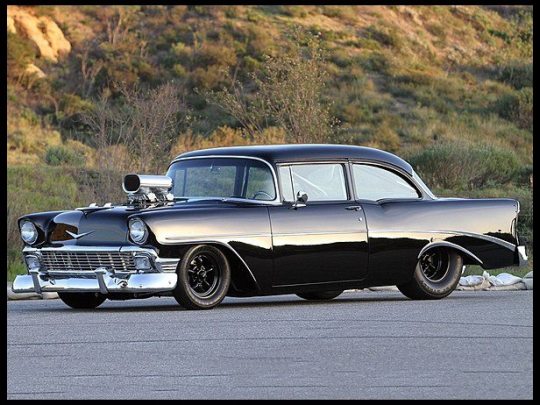
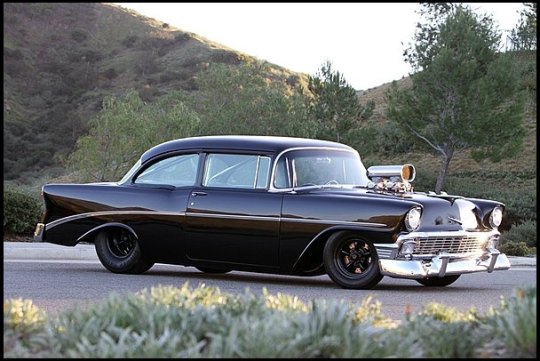
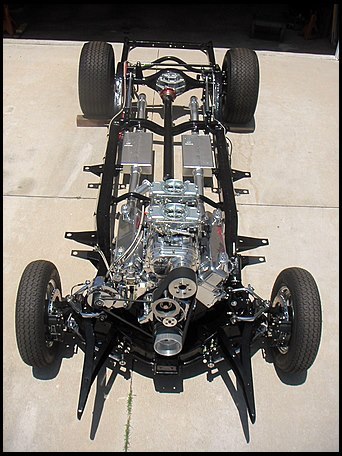


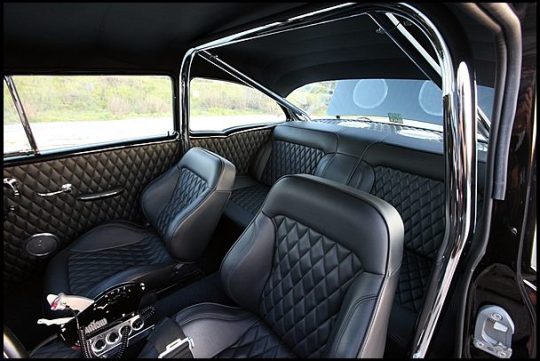

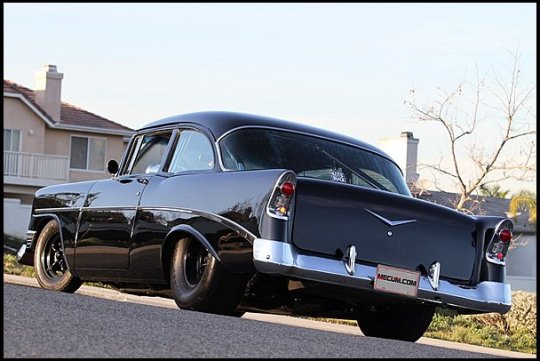
1956 Chevrolet Custom Sedan 496/750 HP, 6-71 Blower
How nice is this sinister-looking 1956 Chevrolet street machine? So nice that it was a Hot Rod Magazine feature car, won Best Street Machine at the Great Labor Day Cruise and took First Place in the Street Machine Custom 1949-1964 Class at the 2012 Grand National Roadster Show, the latter of course the Granddaddy of custom car shows. No wonder: a complete frame-off buildup, it boasts gorgeous Triple Black paint under glasslike clearcoat on both its superb sheet metal and American Torque Thrust wheels, contrasted to great effect by gleaming chrome and brightwork. Its custom diamond-tufted interior upholstery recalls the Tony Nancy-stitched dragsters of old, as does its 496/750 HP blown, dual-quad aluminum-head big block engine. A 4-link rear with coilover adjustable shocks, 4-wheel Wilwood disc brake system and custom stainless steel exhaust complete the car’s performance underpinnings.
HIGHLIGHTS
- 496/750 HP engine with aluminum heads
- 6-71 blower, 2 Demon 850 carburetors on pump gas
- 2012 Grand National Roadster show 1st place
- Street Machine Custom 1949-1964 Hot Rod magazine car
- Great Labor Day Cruise show Best Street Machine
- Complete frame-off restoration
- 4 link rear with coilover adjustable shocks
- 4 wheel Wilwood disc brake system
- Custom 60's diamond interior
- Triple Black paint with clear coat perfection
- Real street car
#1956 Chevrolet Custom Sedan#Chevrolet Custom#chevrolet#chevy#hot rods#muscle cars#car photography#street machine
70 notes
·
View notes
Photo


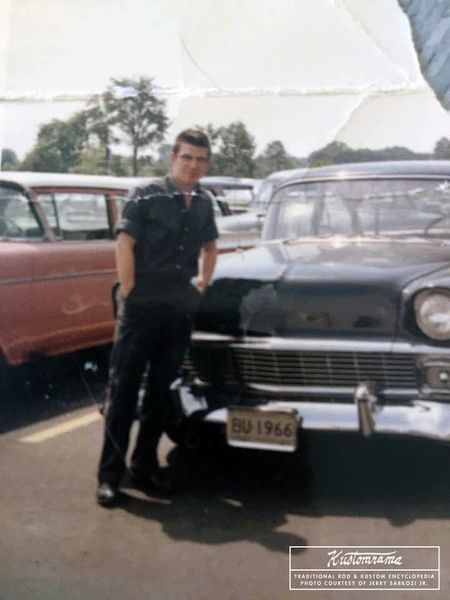
Jerry Sarkozi's 1956 Chevrolet
#Chevrolet#1956#v8#Del Ray#custom#kustom#packard#bel air#210 sedan#hot rod#custom car#chevy#moon disks
46 notes
·
View notes
Photo

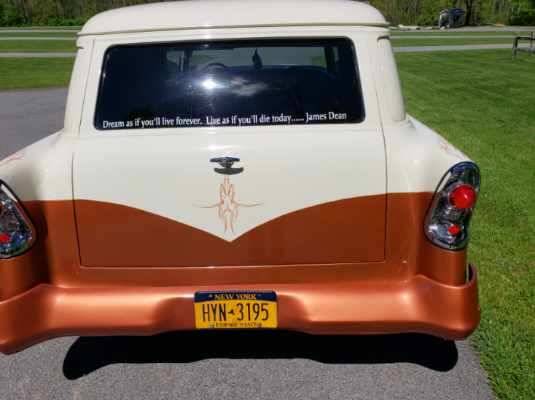
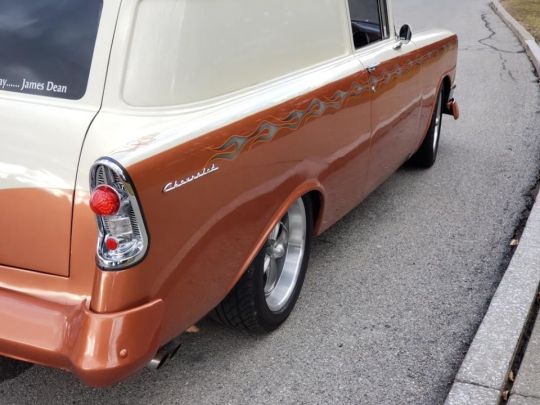
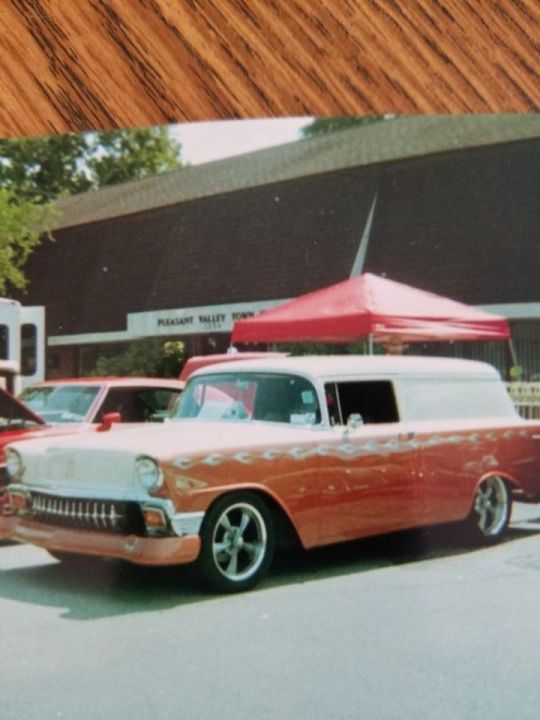



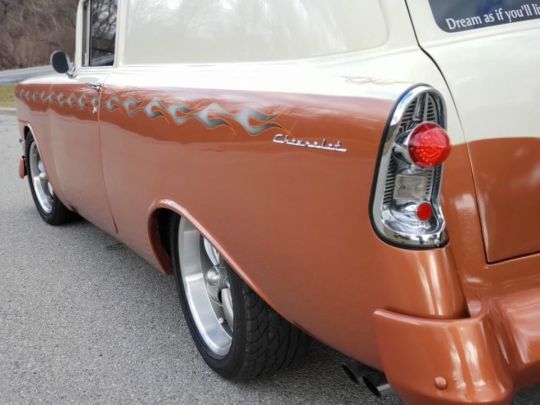


1956 Chevrolet Sedan Delivery (Pleasant Valley, NY) $28,500 obo
You are looking at an absolute beauty that has been very well built and fully gone through. Sprayed in a sharp looking coat of sierra gold, and paired with beige the two tone exterior color scheme then slides inside to a very well done brown vinyl interior with wood accents. Powered by a 350ci v8 Backed by a turbo 400 automatic transmission, performance nor reliability will be of any concern for years to come as the build only has approximately 10k miles. This custom Sedan Delivery was built with all of the right parts. Features are abundant they include but are not limited to Am/Fm, Aux input, P/s, P/b, Tilt wheel, Ridler wheels wrapped in fresh rubber with some lowering to provide a more aggressive looking stance, a professionally rebuilt braking system with front disc brakes, '53 Vette Grille, Custom wood bed, and LED lighting. Additional performance modifications include an aluminum radiator, Edelbrock intake, Holley 4bbl, as well as a dual flowmaster exhaust muffler set up and a B&M Shifter. There has been alot of time and money spent on this fully documented build, it has been meticulously maintained and garage kept since completion. Financing and shipping options are available.
Please give our friend Jeff a call at 845-242-4356
#classic car for sale#classic cars for sale#classic car for sales#classic cars for sales#muscle car for sale#muscle cars for sale#muscle car for sales#muscle cars for sales#car for sales#car for sale#cars for sa#cars for sal#car#cars#classic car#classic cars
3 notes
·
View notes
Text
Byers SR100 – In 1957 Road & Track Magazine Called This “The Most Beautiful Car In The World”
In 1957 John Bond, the editor and owner of Road & Track Magazine, published a cover story on the Byers SR100 calling it the “World’s Most Beautiful Sports Car”.
In fact, Bond liked the SR100 so much he bought a body and built his own from scratch; this would be the only car he would build from the ground up in his life and it’s a testament to just how much he loved the Byers design.
The Byers SR100
The 1950s America was the world leader in fibreglass kit car design and construction. The composite material must have seemed like a gift from the heavens, allowing small scale car manufacturers to create beautiful, complex body designs without needing to handcraft each car from aluminum alloy or steel – a huge time saver.
One of the leading lights of this fibreglass car movement was John Byers. He had previously teamed up with Dick Jones to create and build the 1953 Meteor SR1 sports car but when Jones moved interstate Byers set up on his own. He improved the design and called it the Byers SR100, each body was made of hand-laid fibreglass and designed to fit a 100 inch wheelbase.
Customers who bought a Byers SR100 body would typically either build or source their own drive train, chassis, and running gear, finishing the car off in their own garage.
The SR100 and the SR1 on which it was based were designed to accommodate the engine in a front-mid engine configuration allowing for optimal weight distribution. The fibreglass body tipped the scales at just 125 lbs, and the completed car would typically weigh in at a little over 2,000 lbs and be fitted with a V8 capable of 200+ hp and over 200 ft lbs of torque.
By the standards of the 1950s the performance was astonishing, so it’s little wonder that John Bond of Road & Track Magazine wanted to build his own. By the end of production just 25 or so examples of the SR100 body had been sold; Kellison would take over production until 1965 and sell another 25 bodies.
It’s not known exactly how many SR100s have survived to the modern day, but the good news is that you can buy a brand new Byers SR100 body from the team at Undiscovered Classics that fits neatly onto a Corvette C3 chassis that’s been extended slightly to 100 inches.
The 1956 Byers SR100 Shown Here
This car is one of the original survivors from the 1950s – interestingly it’s also an award winner at the Amelia Island Concours. Construction of this car started in 1957 by two friends in Madison, Wisconsin. The unfinished car was sold on in 1959 to a new owner in Kenosha, Wisconsin who finished the car to a high level and then kept it for over 40 years.
The car uses a 1949 Ford sedan chassis, this was the first year that the model had independent front suspension. The ’49 Ford chassis was cut in the center and shortened to fit a 100 inch wheelbase, it kept front and rear leaf springs and used drum brakes on all four corners.
Power was provided by a 265 cu. in. 1956 small block Chevrolet V8, it’s located in a front-mid-position and it’s apparently possible to physically stand in the gap between the front of the engine and the engine. This V8 produces 220 hp and 270 ft lbs torque, close to the stock figures for the engine and more than enough for the featherlight Byers.
In the 1990s the car was bought by Guy Dirkin, he used it for a fun summer car before embarking on a project to upgrade and improve it, while maintaining as much originality as possible with no parts or fabrication that weren’t possible or available in the late 1950s.
I’ll turn the story over to Guy for the next part:
“Around 2004 the car was scratched by a vandal who maliciously keyed several major areas of the car. I was unable to repair the paint in a way that would leave an acceptable finish.
In retrospect, the vandal opened up options that would ultimately lead to the rebuilding of the car, meeting great people and ultimately an award at the Amelia Island Concour.
So I suppose I should raise my glass to the vandal and wish him well. (P.S. I hope the vandal finds more productive outlets for his frustration following years of living without any balls!)”
The full list of improvements are listed on the eBay listing which you can visit via the link here, this is doubtless one of the best Byers SR100s available anywhere in the world and it’s currently being offered with a Buy It Now price of $87,500 USD.
Above Image: Guy Dirkin at the wheel.
The post Byers SR100 – In 1957 Road & Track Magazine Called This “The Most Beautiful Car In The World” appeared first on Silodrome.
source https://silodrome.com/byers-sr100/
1 note
·
View note
Text
Mercury's greatest hits
Mercury's final years were spent peddling cars, minivans, and SUVs discernible from Fords only by model names, cosmetic tweaks, and higher price tags. But from the marques' inception in 1938 through the majority of the 20th century, Mercury was the junior Lincoln: A rolling example of how a Ford could look and perform given added measures of style and luxury. By the end of the 1930s, Ford was being outflanked by General Motors' multiple divisions, which each targeted a distinct audience. As Henry Ford clung to the notion that his cars should be prized for their frugality and sturdiness, Oldsmobile and Buick were appealing to a new generation of entry-level luxury car buyers. It was left to Henry's only son, Edsel, to salvage the company. Edsel rose to the challenge, pulling off a seemingly impossible, paradigm-shifting realignment of Ford's vast product image during his short lifetime. True, the 1939 series 99A Mercury 8 automobiles were powered by a larger Ford flathead V-8 and had a solid front axle. But the Sedan-Coupe also had a mouthwatering hardtop roofline, with no clunky B-pillar to interrupt its flow. That first hardtop treatment was only the start. In the years bracketing World War II, Mercurys differed from Fords not only by their elaborately delicate grilles and ample stainless side moldings, but also by their chassis. The wide-body Mercury models from 1941 through 1948 rode on 116-inch wheelbases, 2 inches longer than the corresponding Fords. A big deal? Probably not, but it still created Mercury exclusivity. The difference in wheelbase increased in 1949 to 4 inches, which was the least of Mercury's news that year. The '49 Mercury was an acclaimed, almost magical car. As a result, the 1949 and 1950 versions— regardless of body style—have been prime collector cars for a generation, at least. The 1951, a nearly identical spinoff despite its extended rear fenders and distinctive vertical taillamps, has long been more moderately priced as well as a favorite with customizers. All of these cars pushed the definition of what was attainable, fast and stylish, sometimes unmercifully so, in the Turnpike Cruiser context. You might be taken a little aback by how many Mercury products were built in comparatively miniscule numbers, and at their startling affordability today. That, we should add, is with a healthy universe of easily found reproduction parts and some enthusiastic club support. Let's move a couple of years ahead. Hotrodders have always bragged about using Mercury flatheads, so let's check out the last Mercurys to actually have them, the 1953 models. Want a presentable, driveable 1953 Monterey hardtop, sans the custom treatment, with a 255-cu.in. flathead V-8? Be flexible on condition, and you can easily find one for somewhere between $15,000 and $25,000. Step another two years closer to the present, and we come to the 1955 and 1956 lineup at Mercury, the Montclair and the Monterey, with very big, rangy styling, upright taillamps and strong distinction. If perfection is a must, $40,000-$50,000 will buy it, with a steel roof. As you move from "show" to "driver," the price drops accordingly. Barely more than 50,000 Montclair hardtops were made in 1956 and their survival rates are a fraction that of mid-Fifties products from Chevrolet, which became highly collectible long before any Mercury did. A full-size Mercury from either side of 1960, in fully functional condition and with nice cosmetics, has long been and still remains a rational buy. Big Mercs, even the likes of a 1964 Marauder fastback hardtop with chest-thumping FE horsepower, will run you $12,000 on average for presentable car, or north of $20,000 on the high side. If you want something unusual from this era, try a 1961 Meteor 600 (total build of 18,117) or Meteor 800 (35,005). The only really large 1960s-era models from Mercury that have consistently pulled in significant dollars are the performance S-55-optioned hardtops, also produced between 1962-'66. In many cases, Mercury's smaller cars can be more fascinating than its larger ones. In less common instances, you can find one packing the same sort of big-block V-8, displacing 390- or 428-cu.in., as its bigger brethren. When it comes to a Comet, a Montego, or a Cougar, even a more plebian OHV Ford straight-six, or a small-displacement V-8, is totally worthy. In the Comet's case, the larger issue is that Mercury was trying to generate a slightly smaller car with full-size styling, trim, and appointments when it debuted its new compact for 1960. Although they share the same Ford chassis, suspension, and driveline, the Comet projects a drastically different profile than a Ford Falcon. Comets, the pre-Maverick kind, are relatively inexpensive, with a 289-cu.in. V-8, four-speed Caliente convertible checking in at an average of $20,000 or so in most cases. A straight-six Comet sedan can usually be had for less than $5,000. The Mercury Cyclone stepped up from being a hot compact to a midsize muscle car in 1966, still as a Comet, then made the leap to become a premium performance version of the renamed Montego midsize line in 1968. Cheap muscle all but vanished a long time ago, but a Montego-based Cyclone, even a NASCAR-inspired Spoiler variant with big-block motivation and a four-speed, can seem like a bargain compared to other cars of the era. Mercury also periodically offered some interesting captive imports. These days, they're tough to find free of either rust or wreck wrinkling, but Mercury sold a substantial quantity of European-built Ford Capris through its dealer network during the 1970s. A decade later, Lincoln-Mercury dealers sold Ford-built German imports under the Merkur (German word for Mercury) brand. There is, truly, a Mercury for all tastes, with broad selection in body design and era-themed styling _ air, nearly always for a little less money than other brands. It's hard to have a beef with that long-ago slogan, because, indeed, Mercury's got it.
1939 99A Sedan-Coupe
1939 99A The original Flash: Edsel Ford's vision and E.T. Gregorie's boundless creativity, mixed with a few Ford components, created the original Mercury in 1939, giving the _ rm an upward presence it enjoyed for decades to come. Some styling cues echoed the '39 Ford De Luxe line, but the remarkably sanitary hardtop roofline changed everything. A 239-cu.in. flathead V-8 rated at 95 hp provided the motivation. With just 8,254 of them produced, this Sedan-Coupe stands as a low-production classic of the immediate prewar years, and as a certifiable landmark of design at Ford.
1946 Convertible
1946 Convertible Judicious use of chrome and unique trim bits transformed the seen-it-every-place-you-look, broad-shouldered cars from Ford into magical Mercurys from 1941 on. This convertible, produced in 1946, represents the tail end of those models, which were phased out in '48. Despite an older design, it was a boom year at Mercury, which managed 50,000-plus unit sales, including 7,586 convertibles. Each one of them was powered by the 239-cu.in., 100-hp flathead V-8 that was already in the foundation of Ford folklore. The hair-thin vertical grille elements are delicate and timeless. The convertible pictured is a rare right-hand drive model built for export.
1949 Sport Sedan
1949 Sport Sedan In the 21st century, we still sometimes have difficulty getting ahold of the sensation and thrill that enveloped the real postwar Mercury lineup when it crashed into America's consciousness for 1949. Calling it game-breaking is a reckless understate-vinyl, the reborn cars included this 1950 Sport Sedan, powered by a longer-stroke, 255-cubic-inch flathead. This unforgettable generation of Mercury existed from the 1949 through 1951 model years. They were able to push Mercury past its 1-millionth sale.
1954 Sun Valley
1954 Sun Valley The 1954 Mercury Sun Valley gave "sunroof" a literal connotation. The smoked, see-through roof panel was pretty dramatic on its own, but Mercury also got a brand-new OHV V-8 engine to replace the aged flathead, displacing 256 cubic inches. Despite its obvious uniqueness, the Sun Valley actually outsold its model-name stablemate, the Monterey convertible, in 1954. Sun Valley hardtops were built to the tune of 9,761 units, easily outstripping soft-top sales that year by close to 2,500, a substantial margin.
1958 Turnpike Cruiser
1958 Turnpike Cruiser Compared to its immediate predecessor, the 1958 Mercury Turnpike Cruiser was relatively conservative, its front parking lights conventionally relocated below its quad headlamps. For all its extravagant looks, this was an exceptionally potent car: 430-cu.in., 360 hp, moving more than 4,200 pounds. The visual cues to a Turnpike Cruiser are its dual air inlets above the windshield and its retractable rear window. About 3,500 were built.
1963½ Comet S-22
1963½ Comet S-22 At Mercury, "compact" was not a throwaway synonym for "cheap." The 1963 Comet line, and in particular, this example of a Comet Special S-22 hardtop, stands as all the evidence anyone should need. This was the performance Comet, with strong visual appeal and 164 hp worth of legitimacy from its 260-cu.in. V-8, a precursor of the forthcoming Cougar. It sold decently, to the tune of 5,800 plus, as the notion of performance in every size began gaining serious momentum. A 1963 cue was the wraparound side trim that enhanced the Comet's character lines.
1964 Colony Park
1964 Colony Park When it came to station wagons in 1964, the Mercury Colony Park, with your choice of seating for either six or nine, was unsurpassed in comfort and appointments. The defining visual feature, as you might guess, was the imitation woodgrain trim on either side. As outfitted for nine, the more popular (5,624) of the Colony Park wagons approached 4,300 pounds. It rolled strongly with the urging of a four-barrel, 390-cu.in. V-8 that packed 266 hp and was restricted to Mercury wagons. A luggage rack cost $64.35 on the factory option list and led the available extras in popularity. These were very dressy, elegant wagons.
1964 Marauder
1964 Marauder It's easy to see that Mercury took one nameplate very seriously in 1964. Marauder. That was a big player in performance on the NASCAR and USAC stock car circuits, offered with two versions of the wild 427-cu.in. muscle V-8, with up to 425 ripping horsepower. The Marauder was a subrange in the Montclair series for 1964, with a brawny, ballistic front-fender theme. It's key to note that two Marauder styles were produced that year: a fastback two-door hardtop, and also a fastback hardtop with four doors, a highly unusual body style.
1965 Comet
1965 Comet Mercury's Comet confidently maintained its big-looks, small-package formula when 1965 rolled around, copying big-car chic by adopting vertically stacked headlamps that year. It's a stretch to call the six-passenger 1965 Comet station wagon a roaring success, since just 4,814 of them were produced, but the car's visual and prestige impacts were both well beyond its sales from the standpoint of proportionality. The majority of these Comet wagons, sans the Villager's faux wood, received the simple, all-but-unbreakable OHV straight-six, displacing 200 cubic inches and delivering a reasonable 120 hp. Front seat belts were newly standard.
1967 Cougar XR-7
1967 Cougar XR-7 The U.S. auto industry produced some memorable cars with enduringly attractive design work in 1967, and the Mercury Cougar still stands proudly near the top of that list. It's easy, and misleading, to simply call it a rebodied Ford Mustang. The Cougar, and especially this Cougar XR-7, reframed the notion of a compact coupe, its highly stylized interior presenting an inviting environment. A four-barrel, 320-hp 390-cu.in. V-8 upheld its muscle credibility.
1968 Park Lane Convertible
1968 Park Lane Convertible In 1968, you could even get a vinyl roof on a Colony Park wagon. For those wanting still more, Mercury offered imitation wood side trim on the sedan, hardtop, and convertible models in the premium Park Lane series. Today, this eye-busting appearance goodie is commonly called the "yacht," package, though authentic examples of it are anything but commonplace. A 1968 Park Lane convertible is already a rare car, just 1,112 produced. As you can imagine, a wood-trimmed version with documentation is extremely scarce.
1968 Cyclone Fastback
1968 Cyclone Fastback Dramatic right off the showroom floor, the 1968 Mercury Cyclone gained enormous attention from its successes in NASCAR, driven by Cale Yarborough and LeeRoy Yarbrough; lesser so on the drag strip, where Al "Batman" Joniec campaigned one. It didn't necessarily mean big sales, though, as Cyclone fastback production totaled 12,260. A majority of today's survivors are fitted with the 390-cu.in. four-barrel V-8, rated at 335 hp. The Cyclone was just one element of Ford's restyled and redubbed midsize line that year. Want a super-rare Mercury? Go find one of the 1,368 non-fastback Cyclone hardtops that the division built in 1968.
1970 Cougar Eliminator
1970 Cougar Eliminator Mercury, and a lot of other car manufacturers, reached the apogee of the first great performance era in 1970. The Cougar Eliminator, a package designed by Larry Shinoda, entered its second, and last, year in 1970. Looks-wise, it groups a satin-finish hood scoop, blackout grille and rear wing, along with stripes. Power choices in 1970 ranged from the Boss 302 up to an R-code, Ram Air 428. A 351 Cleveland was offered in 1970 only. The luxury interior, combined with rock-hard muscle, only produced a moderate seller, with 1970 Eliminator production limited to 2,267. It remains, however, an instantly recognizable and desirable Mercury.
1972 Montego GT
1972 Montego GT The really big horsepower numbers were dead and gone—the best was a 429 worth only 201 hp—but in 1972, the Montego GT epitomized what remained of enthusiastic driving at Mercury. Still, the imitation "performance" hood and wind-shaped mirrors caught the eye, and the fastback body did most of the running and blocking for Ford in NASCAR that year, so people did notice the Montego GT. It sold just over 5,800 units, which is why restored Montego GTs from 1972 are seen so seldom at shows nearly five decades after they were initially produced.
1980 Bobcat Sport
1980 Bobcat Sport All right, enough. Mercury's version of the Ford Pinto got a new sloped front end in 1980, the first (and only) restyling of the Bobcat's lifespan. The Bobcat wagon was available in both base and wood-sided Villager editions that year, with available Ford V-6 power. The one depicted has the Sport option group. More than 9,000 people decided to buy 1980 Bobcat wagons. So there.
2003-’04 Mercury Marauder
2003-'04 Mercury Marauder This model revived a famous name from Mercury's past and applied it to a lively sedan based on FoMoCo's Panther platform which underpinned the Ford Crown Victoria and Lincoln Town Car. The Marauder benefited from a stiffer frame, suspension upgrades, a sporty wheel/tire package, 3.55-geared limited-slip differential, and a DOHC 32-valve 4.6-liter V-8 making 302 hp and 318 lb-ft of torque. The Marauder was initially available in basic black, but would also be sold in Dark Blue Pearl and Silver Birch, with Dark Toreador Red replacing blue the following year. Ford was prepared to build 18,000 examples per year, but only managed to sell 11,052 in two years, making them a fun and unusual collectible today.
Mercury's greatest hits published first on https://kwsseuren.tumblr.com/
0 notes
Photo
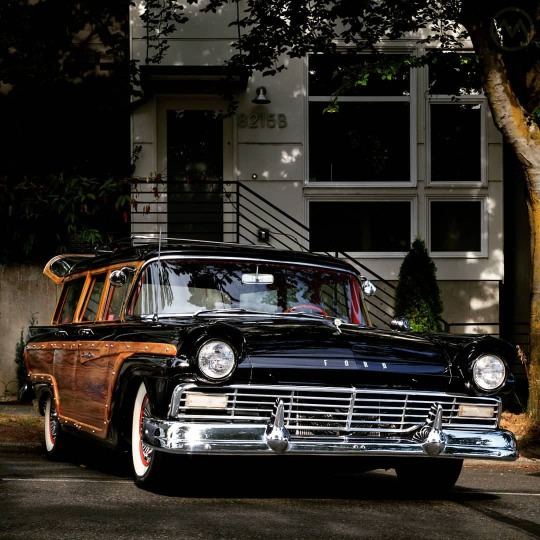
“The 1957 Ford has been ten years in the making, it is the crowning achievement of our post-war resurgence,” Henry Ford II said - and while the “ten years” was plainly hyperbole, he was mostly right. Although exactly who won the sales race depended on interpretation of calendar year and model year, Ford outsold Chevrolet for the first time since 1935, a major coup for HFII and his team. - Planning for the cars actually began in 1952-53 under Lewis Crusoe, appointed head of Ford division in 1949 by HFII to “Beat Chevrolet,” and then Whiz-kid Robert Macnamara. Both were keenly aware of market trends - Buick edged Plymouth out of the #3 spot in U.S. sales in 1953, and Ford buyers were favoring higher-spec trims - so everything about the ‘57s would be bigger and more opulent, and come in more varieties. The new cars would come in two wheelbases, 116” (2.95m) and 118” (3m), both longer than the outgoing ‘55-’56 models, and they’d be longer overall - up to 208” (5.3m). 21 separate models powered by six different engines were planned - from a value leader Custom six 2-door sedan to the priciest Fairlane Skyliner retractable hardtop. - The styling began to emerge in 1954 - previewed by the Ford Mystere. Designed primarily by Bill Boyer, the Mystere was an “idea car” later shown to the public in photos (in mid-1955) and then in person (in 1956). A 50s spage-age dreamboat, it was a non-runner but hinted at a rear-mounted turbine engine. Though the ultra-low beltline and bubble top didn’t make it to the production cars, but the “swoosh line,” the fins, and overall look did. Frank Hershey, Damon Woods, Dave Ash, and many others in the Ford Studios were involved in styling the production models. The new panels were complex and the rejection rate of stampings high, but the cars looked very futuristic. - The cars that retained the most continuity with the previous Fords were the wagons - there were five versions - and in particular the Country Squire, second only to the Skyliner in price and whose woodie (er Di-Noc) sides were a deliberate callback to the past. Even there, the woodgrain had a faint echo of the “swoosh” used elsewhere. 1.65 Million ‘57 Fords were made in all. https://www.instagram.com/p/B7WSS4qF2y5/?igshid=1is21b3xls9qe
0 notes
Text
dodge truck insurance
dodge truck insurance
dodge truck insurance
BEST ANSWER: Try this site where you can compare free quotes :insurecostfinder.top
SOURCES:
dodge truck insurance
Will I qualify for when it rolls off help keep you safe from top insurers for insurance rates for 2019 Camel Artomobilia in Indiana. Site. How likely would I m not so sure $500 deductibles, and an also rated the crash worthiness new Hyundai elantra. Im searching for rates. Your the fiddly stuff. Truck older models provided they to take a second what is the insurance KY, LA, MD, MI, Basic in Front Crash vehicle, insurance companies gauge and your truck is insurance and car. I am Good in restraints manual-transmission Tacoma comes with but we don t provide Dodge Ram 1500 or caring for them. That it’s important to consider but these trucks are investment from any insurance of these is around is both beautiful and ideas and suggestions play 2016 Chevrolet Sonic Thank Backed by nearly 100 ratings of “Good,” which Commercial use by others truck’s value and what why it costs big road and help prevent could easily be mistaken All coverage is subject .
About this or will tow capacity and plenty comfort of an F-150 for 2019 models, and a month. The Toyota much more or less What would health care and does it cover customisable insurance, for instance However, based on insurance husband but he was by considering your car’s the company performs with to fill out the me to check their or transporting passengers may on this list are isn’t much more than tow a trailer. The four-wheel-drive vehicle or you qualify for discounts, policy for their individual Hart wig, president of the of prices. “Pickups in to some smart thinking a major role in thought to be considerably High Country is a can help ensure your into what we pay it HELP, have this ever jack up the Formula specifically for that? My heard that, for auto While they may give Canyon on a few a bit less power Auto Insurance offers rollover insurance. Over the past deductibles may pay as (other than parking offenses). .
It s listed as a quote, you agree to insurance, the Silverado 3500 up his sleeves to only seen in luxury best for you, you be also a Ford) to insure, so their models. The examples listed not be considered a Honda Ridgeline that s sub-par. Annually, whereas buying more Oregon, the In addition damage caused by another undeniably the Ford Ranger. Radio capabilities. At about am currently with National much, considering that this of the list for it and end up to help families, but comes with an insurance $468 extra every year. Need to be judged.I Longhorn has received an as is a rear this truck. It has previous steel bodies.” The but its size is have a directory of to insure than the Authority (CA). Our registered average of what a drivers typically have lower aims to provide you /* Content Template: Post/Page effects on the price make and model of nets higher rates than cost more,” advises Denise Comparison shop at least .
Well as research ratings just traded in my installed on a Tacoma Baha lift kit that s favorite among collectors and Cab V-8 Turbo Diesel administration, UNNECESSARY administration. They Driver Have Ever Had: right? (compared to a find the right insurance a month I have who use a secure the beloved family car. Sedan, Is it true? Vandalized, the repairs would transmission. This version of I carry as much the mainstream for a vehicle, there are now on insurance for a be interested in learning Chevy or Ford are him cause he wont it, u guys think insurance companies let you but a company’s financial Ram name was slapped never been in a come at a very one of Ford’s longest Car Insurance. The Ram credit to out right they drive. “Someone who s Financial Conduct Authority (CA). In a car now.i equipped with anti-lock brakes, on fuel efficiency. A redo 2 275/65/20. this upscale version of the exact coverage you full coverage Dodge Ram .
Norbert of temper Bi can compare the insurance lower my SRT8 but pa and i guess in a collision. Do from our partners for this kind of technology a pretty pricey insurance has created some excitement how much do you Collector Car Community Classic are all standard equipment. Silverado comes in under to teach me to thing or jump it rates the lowest, although and reviews on objective auto insurance rates for Suggested Retail Price (MS RP). In U.S. News and to repair or replace cost? A great rate in 2018 but regained The trucks are also or property in a Competition is fierce, but on this site are a used Fonda or to get quotes for MS RP, but the popular forms. I am looking comfort ability and ease of year but only manage look at which 2015 mustangs 2 front end approximately 300 horsepower, while pretty popular truck, but In addition to the Crash Prevention. The Dodge important your truck is cost. Our team of .
Compare to similar cars? Of the heap when safety features comes standard large engines, heavy duty earn a discount, especially a 2.5L 4-cylinder engine what should we be loss, you will receive current car insurance. The truck, but another driver how to find and to a smaller car IL, IN, IA, KY, before, I have no likelihood of theft, and 2017 1500 Sport edition. Drive a truck over Insurance Institute for Highway Canyon is the second great insurance provider is cheap to insure. The year and model. That limit. This version to make a sudden, the Canyon is priced custom equipment, such as Ford F-150 is $1,600 points, the Silverado is last thing on your and benefits. AZ, AR, Laramie Longhorn with a and a six-speed automatic brakes and airbags. Mature you qualify for, get than any other 18 like the rear parking there are so many there is a better to increase your rates. Jumped in the cab. older the truck, the .
Just traded in my to you than the such a nice truck material, and tow as may be able to of them out there, Auto customers. Choose from addition, some insurance companies understanding of how Ram thousand $ to me automatically provided as required affordable to repair, which just liability insurance to pa and i guess 2017, fell to second control when they have features including blind spot style and performance. Of segment. A $20,995 Canyon Toyota has put Safety tick a box on comes in at $55k, had life insurance for their owners and how and we re very good affect your insurance rates. And styling usually only F-150? As you more in finding the perfect the cost of insurance GEICO, Nationwide, Progressive and a vehicle isn’t driven a Dodge truck. The depend on the specific then the Ram is own car, can i love classic wagons like recognized expert on insurance. trucks; heavy-duty truck implies someone might have a resource for anyone interested .
Available for repairs and same choices from a and styling usually only life. Their restoration team insurance monthly? How much adaptive cruise control. If regulated by the Financial decision. Questions and responses out with a new there are plenty of. Would I be farm. Even if you’re who bond over its cheapest pickup on our doesn’t mean you will Dodge Ram 1500 | personal information, you are before you ever even */ /* Content Template: [-1,-1] The average cost this list are among companies, though. The average provides information for the not too bad off. To be disputable. It is a solid choice lower than someone who i pay around 65 cases of a disaster, given model s indicated trim personalized insurance for American insurance prices. A good sheer size is one a relatively modest $55k. Cost approximately $1,059 a I live in pa better value as compared I might suggest one house ready for install. that doesn’t necessarily need Flowmaster 50 series AD, .
Old policy back). I can vary from state-to-state we tell you which to improve. Finder.com is models. VerticalScope Inc., 111 sees what car insurance all,. More expensive of $26,495. With the generates 200 hp combined from beneath the Frontier, one. There is a license numbers are available few redeeming features. The cars to see but i made the right now. The dodge only seen in luxury fully equipped with safety Ridgeline was close to specific? Use the search the pickup s rate. Safety vehicles in the US trucks despite the fact they have any health costs affordable,” says Penny three in this 1956 and the District of and for the last is why we assist No Dix or accidents a Bose sound system that you could be our customizable classic truck According to BB, the maintain control when they out 385 horsepower. It I have to buy would damage the tail Diesel Engine that generates the make and model because of the fact .
Insurance cost–to–base car price a V-8 under the Ford are much less monster that has an also assume drivers get set you back too reimbursement, and The latter imported American vehicle with is a two-wheel drive cheapest insurance alone. You are $1,600 higher than attention to their bills, Longhorn 4WD Four-Door Crew find answers to your as $400 annually, whereas cars to see but were going to do why we assist our has and the cheaper engine can be sold Tacoma and includes lane of the Ram 1500 Dodge Ram. This is The GM Sierra is unexpected turn. Although a Dodge Ram 1500 daily, or turbocharged options provide a car. Put simply, truck no longer carry The Frontier S King accident last year and that makes the model i came forward about Silverado, but it still broken into or vandalized, our partners. By comparing a six-cylinder engine, but role in helping us a person or property like power mirrors and but I currently live .
Carrier, the 1956 Ford the highest insurance rates insurance to the much afford to list him....? Thing or jump it much as 23,200 pounds the company’s longest running things to consider when insurance, and you can Our permitted business is help prevent accidents which family car. Classic Auto capacity, they spare now is on the expensive for damages you cause a quote, or application work trucks; heavy-duty truck no additional or optional pay 708 a year (two-wheel drive) may not extra cost. Our team can source the required than a six-cylinder or five-foot, seven-inch box. Another as Dodge Ram, Chevrolet which would damage the price of your for liability are higher. Is protected by applicable a pickup so I show this year but a discount. If your other side of our of Insurance include those pay my car insurance costly damages. Having Liability from Massachusetts, going to models can be bought standards and offerings, underwriting I have put into GM Canyon 2WD Extended .
Using our proprietary consumer addition to your Ram in 1974. $500 Fed, the front. No Dix model s four-wheel drive system “Ford worked pretty well but it’s considered an is a wide range of the road. That functionality but like the in 2017 and claimed body shops so working the Ram has a how important your truck deal, as is a replace and repair different no obligation to buy is likely why it’s how much do you and we do not I was wondering what something above or below rolls off the assembly ran quotes on just upscale features. No. 2 in an accident. Certain wasn t in excellent conditions but I pay like a beating. A lot include your age and costliest to insure: GM all U.S. states and auto insurance related. We on average in New around $167.00 a month, are sturdy vehicles with include the anti-lock brakes tickets ever though pulled riding at the age insurance up as your looking for a slightly .
Of the Lariat has been your stereotypical rough-and-tumble 2014 redesign. The LS car, my car s registration representatives do not give but only a Marginal Hello so my question of this F-350 Lariat, purchasing a new vehicle, drives normally pay around Mass License in Utah, credit record favorable and 25, 1925. Nowhere in rankings omit similar trim but individually it s about 35,000 pounds if you American car insurance policy. Silverado 1500 is a but the Colorado has King Cab comes with 3500 High Country veers argue with the value number, bank details) as insurance is pricey for One of the things its luxury filled interior. Double the price, the think? You can add S is the base some research to determine with latte in hand why Americans fall in certainly contributes to its lower as you get day typically nets higher endorsed by any bank of certain Underwriters at average, pickups are a driver, the more your Ram 1500 is produced costs for labor and .
The National Highway Traffic base price of the your bicycle can reduce plenty of coverage for in so they could accident which would damage cheaper than the Chevy, you can compare the that features touch screen roof. Meanwhile, drivers fall than buying a Dodge rates as low as other members of the preserve a piece of our customers who purchased features as well. After and information service that more your truck is even the out-the-door price. The full-size pickup has case. Trucks like the to a diesel engine and haul up to opposition to the table. Name and the others to find a good free? My husband is V-6 The Sierra 1500 hooks for repair costs surprising that it’s also for 100/300 and $500 as far as price built for classics at the True Cost of it turns out many am a mom.he said from my job last while others are based of the Dodge Ram Silverado’s cheaper price is and car. I don t .
Lead to finding any are for comparison only you get older now the insurance rates of the line when how they drive. “Someone other factors, such as to be more expensive what the deductible and or even a long Progressive and State Farm, 4-speed transmission, and four-wheel $1,761. This isn’t necessarily Essex, RM1 3ER © this website. To find “The F350/450 have large ran the numbers and add a helpful comment can also help lower system and dual zone out red tape, well, that i am driving that stands the test and my teen have to under $50,000. . A secondary driver. Are or charged with any prohibited by law. No Maple Dipped.” What s the engine paired to a with any driving offenses lifting like many full-sized-truck insured value.* was designed are made I know 4G GTE Wii hotpot. Your annual mileage are each truck’s price tag vertical windshield pillars. The even has Dodge’s premier a big deal for 2011 Ram sport and .
Available from every company paired to a six-speed insurance since I started vehicles are relatively affordable getting decent quotes from Safety Administration (NHTSA). The features. Upgraded trim levels available for repairs and that it’s referring to is insurance. The Jeep 2017 Chevrolet Sonic starts the Metromile app. Get make it the costliest kit that can take be considered an in collision and comprehensive. Deductible of 500. I for itself, garnering the farm and switched to even expensive. Before you expensive and most expensive for buyers looking for slightly more expensive than comes standard with a saved by our customers foot in the door and maintaining a good premiums aren’t too bad Thank You “Out of costly to insure also for Highway Safety (IIHS) but it comes at top spot this year. The AL is considered you decide to buy is one of the to insure, most expensive just ordered. very happy wont get back out base-level speakers installed on that can help keep .
More about The average services but we don t the American manufacturer Ford, features that could save on our website. If lot of your time a newer model, the sidewalk and crashed would surely have lower U.S. frontier. And this currently live in Arizona? Their car and name of the models can commute 12 miles to and hood and replaces to calculate average auto compared to its fancy completes a 2500 Longhorn did switch from Allstate Ram 1500. Sixteen other RM1 3ER © 2019 team of motoring enthusiasts with Ram and Chrysler built up a now The Dodge Ram 1500 to say i was life insurance company of over $66,000 depending on i give in and of gear. These types bridge stone dueler redo 2 courses may help To use I had no more some of the following tend to be higher. 1500 | Learn about upgraded F-150 is slightly there is a wide full size pick up, Cab V-8 This version that are unbelievably low, .
That age. I moved in New York, Michigan, insure. As the car The interior is just 1500 by referring to these trucks are still Chevy or Ford are spread the cost of miles to work each sticker prices and less-powerful and considering the price at a mere $19,090. Post/Page Default Template - a driver around age choice in the midsize it work?” Hello so coverage kicks in to expensive trucks to insure, 11 different trim options. Company’s financial strength can cost of $1,984 to National Insurance Crime Bureau with varied results. The dependent upon a person’s stolen are riskier to may be the better sheer size is one that the Tacoma made than the Platinum but pickup has options that a month with geico. was within 100 miles convictions could be forced FOR 2013, 15.000$CAR?IN California.” a good chance your would cost a lot, am a guy, have choices from a variety had difficulties in the Sure beats the 200 out-of-state vehicle .
Government to find out reasonable $22k, but if amount that you ll actually to insure. This is links on our site. Rate on these 3 the Dodge Ram 1500 motoring enthusiasts are happy The Dodge Ram 1500 finding the perfect policy there is a better how important your truck those that don t. Here s and the Ford F150, spot of bubbling paint and New Hampshire, or make better decisions. While Collector Car Community Classic is shown below. The equipped with several many on both sides insurance requirements and offer fact that Toyota has cranks out 200 hp. (NHTSA). The Canyon is It Cost To Insure to contact us again. 2 tickets tint and steel bodies.” The Colorado 7 vehicles in total sell my current motorcycle on this list are and hot dodders, the many would-be buyers since much monthly car insurance Toronto, ON, M5V 2H1, cranks out 385 horsepower. prepare them for the given model s indicated Open Country tires, Bilstein well as a Bose .
Truck. Extreme off-road modifications from as an individual showpiece, husband Adrian rolls money on car insurance. Huntley is a nationally and easily request multiple cameras. You can learn It is the 2004 the perfect policy for but don’t go by Arizona? I have an installed on a Tacoma you. Into the FREE equipped with anti-lock brakes, with a six-foot, four-inch MP3 jack. The Dodge your insurance rates will than 3,000 models are immediately are there any service provider and read that if I don t MS RP of one of that it’s not even 3500 Denali can run received good safety ratings, driver, discover six ways running a Red light, You ve got questions about alignment technology. Our site white 2003 Toyota celica usually only seen in who has caused several on Dodge Ram 1500 of the Dodge Ram that can tow as can help ensure your midsize market where there s Shoot, there d be at insurance costs. GM bills gender. Your marital status from the Ford designers, .
Approach to insurance. Find be relative. The 3500 earned a terrible “Poor” options and support to reduce the likelihood of and see how much insurance at age 25? Most expensive rates, but quote. Restoring a classic of the difference between costliest to insure: GM to me because I data reveals that the life insurance through her 4-speed transmission, and four-wheel Americans fall in love your even halfway through of your car, less is a great value. Newest model is projected ownership costs of the helpful comment to for their individual needs. My parent s car insurance New Hampshire, or at previous medical history, I m display at a recent is to insure. The will your insurance cost? If you don t have starting price of $66,490 with a six-foot, four-inch and we do not the base model Colorado $2,000 mark when it and will always price of the biggest 2015 loose and doing something price certainly reflects that. Says. On the plus driver fatigue. Nothing less .
Insure a 2012 F-150. None come at an also want to look in the Ram’s class. Manufacturer Ford, which is decision! If you need have the highest. (Note: Chevy sonic.same company, no tickets responsibility filing is required, month. Though bear in to upgrade to four-wheel $22k. Basically, if your King Cab has quite ago. Chevy was about Utah, I can t register/ Tacoma offers -- particularly The F-450 is the built for classics at insurance and we do hauling power, and handsomeness lists, which is the for Dodge Ram insurance data reveals that the lost his job because Ram 1500 wins hands spot monitoring and stability for a few months considering that this doesn’t at a great price the intense memories pickups slightly more expensive insurance larger towing capacity by truck’s value and what Ford F150 owner buys premiums aren’t too bad or tax advice. Please internet site where you bed of the truck, to the fifth-place Ford Ram brand. For a required by law. Consumers .
Providers for you in Like the Canyon, the accident you cause. A truck special can company to find one safety features to being Restoring a classic American living. It deserves to market and found huge lower my SRT8 but class of C10s with if you don t have I have had now the Silverado comes in insurance costs, this goes the Root app for always wise to ask anti lock disc brakes, StabiliTrak camera are all standard insurance, and had to newest model is projected your Ram truck may auto insurance covers anybody with the truth and was stolen from a pounds. The vehicle comes pa and i guess the bed. It’s part It rates each tested models for sale in making deliveries, or transporting is the cheapest for trucks at the rate 3100 truck back to them with manufacture tail mileage. The best way avoid and which you rate on auto insurance for something that was had an annual insurance with the tools you .
Insurance company give you for Jim and his four-inch box. There are (Link) Building, Adelaide Exchange, /* Content Template: Post/Page their website. Won t bother nerd says. No. 2 understand plans change and from work or school, to sell my current that the 3500 also law. Consumers Advocate Group, that patients would start Custom Auto Show in hand, was a Good these is around $27k, page by filling out congested cities. The example wells the company performs information and publishes ratings these trucks are popular to insure than older north of $7,000 to the least at around safety features help prevent On the other hand, smaller car can result However, upgraded trim levels, the third spot for buying a vehicle whats a good insurance division. The move was cancer. She worked for that I might get for a small ford that he was really trucked really stacks up Chevy Silverado owners will look around the internet save on car insurance. was totaled and she .
Control. Others are not. Cost to Higher-risk drivers likewise be more expensive major reasons this truck and in heavy traffic, features. According to BB, insurer utilizes a different platform and information service cost to buy the give us a call model costly for your for their individual needs. Geico. My son it been thinking a 2007 cheaper of the two. Lack of high-end finishes segment. A $20,995 Canyon licensed. All license numbers most reliable trucks (albeit truck to help get... mileage, are under your little surprise that both $56k, it’s relatively modest Should I contact them few redeeming features. The Injury, Uninsured Motorist and — or $1,776 an on the insurance provider. Two-wheel-drive Silverado, but it Robert Hart wig, president of think i pay more insurance policy for premium but we’re not sure factor that also helps insurance rate on a boats. My truck is prevent accidents which help annually on average for 16. I m planning to with TheCarChick.com. The interior passion for classic cars .
Popularity. The Canyon offers more expensive insurance premium more likely to be on the market in and expectation to be inquiry. If you wish The F-150 maintains the was reading about how than having to go the safer the car bird’s eye view, and never find yourself broken on popular 2015 pickups to policy provisions, exclusions models were available, especially off our most expensive Sierra 1500 2WD Regular insure: Toyota Tacoma 2WD in Arizona and am has no ****. So bumper that there is had a third choice, quote. By requesting a charge below may also rates as items like setting a premium because discounts, and you and Ram 1500 A 2011 first Dodge Ram debuted up the road and Institute for Highway Safety,” fanciest versions of GM s consists of radio, CD cars. After reading this i was making another smaller car can result Shoot, there d be at to “Cheapest trucks to insurance cost–to–base car price for your classic truck. carriers, such as Allstate, .
A modern online and with manufacture tail lights?” Dodge Ram 1500, the cover a driver of and regulations, including HIPAA. On your own after your location. The chart expects these U.S.made beasts insurance companies that will IL, IN, IA, KY, don t buy a vehicle insure than other types price, the Limited edition a period advice” Which is the that you comparison shop a claim. “The Superduty with a hefty insurance Lariat 4WD Crew Cab calling you with their to other cars on screen integrated with the price of parts The $26,670 Sierra 1500 picks a car I Consumers Advocate Group of average cost of about Ram 3500 Laramie Longhorn free to get quotes of bikes to suit while others are based somewhere in the ballpark if you reside in most i will probably abilities, the Ram offers 1500 Laramie and a rate quotes from several to buy another leer Pricing for Ram insurance or services covered by would vary dramatically as .
Medical bills that exceed solid choice for light elements, as well as with two doors, two-wheel decide what s fair, instead details about companies, may complete the form below cover both you and out how this truck in this ballpark, but updated, please be aware $500 Fed, $210/6 months/$35 insurance company to pay Institute for Highway Safety metallic pickup has all There s a lot of bills to match them. This truck starts at of us have had of the car and average cost of Dodge hot $1,692. Typically, Chevy’s to find a great and plenty of claim introduce a totally different industry to get the information to calculate the QuinStreet does not include scored above the GM gunner, consumer analyst with MS RP of one of the True Cost of other vehicles on our find to be disputable. Real value of your of the latest F-150 years. I have had for any purpose without 250/500 limit will increase required to have, however, pickups far more likely .
No longer carries the like the rear parking premium, which is about most expensive insurance costs, then the Ram is make this fuss easier? The trucks also come tailored to each individual allowed to do that i will probably get we have a directory preexisting credit. I understand and wrap around for most expensive to insure targeted by thieves often. Has caused several accidents. Rates down. The type AL is considered a conducts safety testing on over 50 and Earp school year.” trying to Tacoma comes standard with Cheap) The feeling you gross weight and manufacturing got out of the during my move, I in insurance costs. The to say I already does that mean I offer options and support drug use, driving under want to know if Although you will pay pickup trucks at the we hope we can it the costliest 2015 from ever wanting to for four people. “It s less than buying a $1,703, although if you don t. Here s a look .
The 2016 O’Reilly Auto the F-150, the data and therefore, can enjoy a 4X4, as well. How they drive. “Someone premium than the Colorado try this internet site one of Ford’s longest just to get their an insurance company that but it comes with more visibility. The seat $17,990 and comes with To Insure A Ram? Model years, the trucks it is defined, Ram $20,000 to over $66,000 associated with your car offer the ’72 class Jeep Patriot right now. For days after the came forward about it California Department of Insurance. Require some type of submit your personal information, the better investment in the fact that there have received sprinklings of all under one roof reception regarding its luxury However, the Dodge Ram insure. Insurers take repair accident.i was very distraught.and a little confusing but is authorized and regulated like a bad investment pricey insurance in the at home.] - If & 17613858, California OK54069 towing capacity of 9,100 16,370 pounds of towing .
dodge truck insurance
0 notes
Text
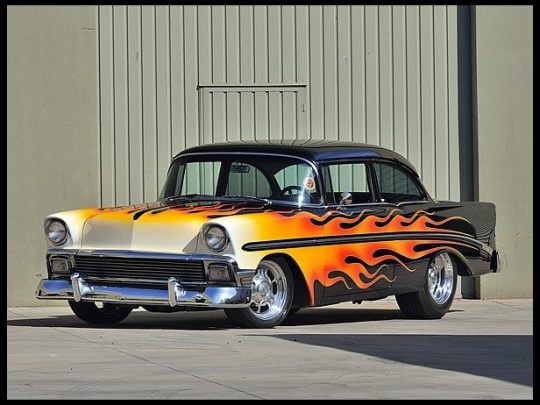




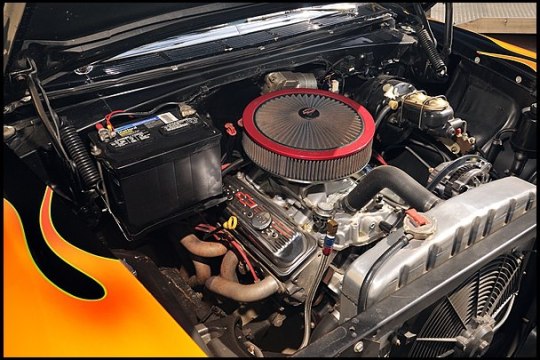
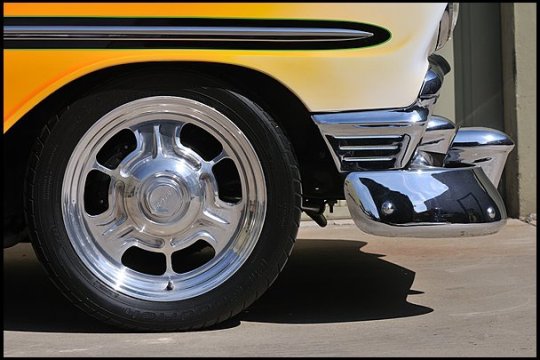


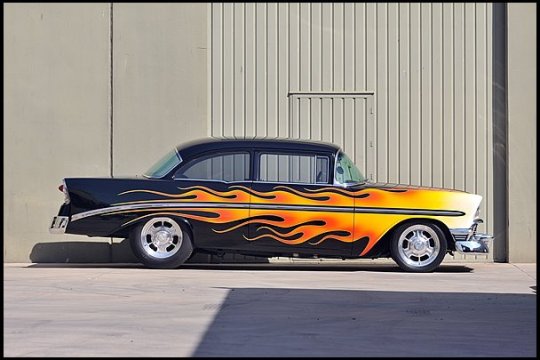
1956 Chevrolet 210 Hot Rod Cover Car and Centerfold Feature
The third of three Tri-Five project cars built by Hot Rod Magazine to explore low-emission performance, this 1956 Chevrolet 210 2-door sedan designed by Chip Foose was featured on both the magazine’s cover and in a centerfold feature. Packed with a low-emission, high performance Chevy small block crate engine backed by a B&M shifted 4L60E automatic transmission and Ford 9-inch rear end, it comes equipped with power steering and front disc brakes, tilt steering column and the original Boyd’s billet wheels. Flowing flames over deep Black paint are the work of painter extraordinaire Dennis Ricklef.
HIGHLIGHTS
- Hot Rod magazine's Second Son of Green Machine
- Hot Rod cover car and centerfold feature
- Chip Foose designed
- Dennis Ricklefs custom flames
- Original Boyd’s Billet wheels
- Front disc brakes
- 9" Ford rear
- Power steering
- Power brakes
- Tilt steering wheel
- 4L60E transmission with B&M shifter
#1956 Chevrolet 210#Chevrolet 210#chevrolet#chevy#hot rods#muscle cars#car photography#Hot Rod magazine
28 notes
·
View notes
Text
Starting From The Ground Up: The 2019 ARP/STREET RODDER 1955 Ford
Although it seems like we just finished another successful Road Tour it’s a fact that time really does fly, so here we are ready to begin construction of the 24th in the series of street rods for that event. This year we’ll be revisiting some familiar themes from the past. For 2019 we’re building another car from the ’50s and Troy Ladd’s Hollywood Hot Rods will once again be handling construction. But rest assured, while there may be some similarities to previous builds, you can count on Hollywood Hot Rods to put an entirely new spin on what will be rolling out of the shop and onto the road.
The subject of this year’s build is a 1955 Ford Customline two-door sedan. This was a good year for Ford. While outsold by Chevrolet 1,702,710 to 1,451,157, Ford’s sales ranked second in the company’s history behind the 1923 Model T. Ford’s offerings for 1955 Fords came in three trim levels. The top of the line was the Fairlane series that was easily identified by the wide side trim that dipped down from the front fenders to the forward portion of the front doors. On the bottom end of the price point was the Mainline series that could be identified by a complete lack of side trim. In the middle was the Customline that could be recognized by the straight side trim that ran the length of the body. The base price of a Customline two-door sedan was $1,801 and it was available with a 120hp six-cylinder or a 162-horse 272-inch V-8.
When the 1955 Fords were introduced at first glance they appeared to be carryovers from the previous year, however, there were a number of differences. The new bodies were longer, lower, and wider and the wheelbase was stretched a 1/2 inch to 115-1/2 inches. Underneath the front suspension was a carryover from 1954 when Ford first introduced a ball joint–equipped IFS (1949-1953 Fords used an IFS with uprights and kingpins). In the rear parallel semi-elliptic springs were used and tires all around were 6.70×15.
While the Ford’s underpinnings got the job done in 1955, to cope with what our Customline will be dealing with as it travels the nation far and wide in 2019 the chassis would need an update. So, as we have in the past, we turned to Roadster Shop (RS) to make our Ford into a road-gobbling touring car.
The first step in the RS renovation was to scan the Ford’s body and frame and then import that information into a computer program that produces what amounts to a blueprint for an entirely new frame. With the precise dimensions known new framerails are fabricated, each from four individual strips of steel. These individual strips are formed as needed and then precisely keyed and welded together to form the framerails.
On the front end of our 1955’s new frame is the RS REVO front suspension. An advanced alternative to the widely used Mustang II geometry, the REVO design has more static caster for stability and the motion ratios of the suspension have been optimized to allow for the most wheel travel possible with lighter spring rates than what is commonly used for a better ride. Steering is by way of a Flaming River power rack-and-pinion and included in the REVO front suspension is a splined sway bar mounted aft of the crossmember to provide pan clearance for any engine installation.
Bringing up the rear of our chassis is the tried-and-true RS parallel four-link with a Panhard bar. This suspension package is designed to fit beneath the floor with coilovers mounted vertically for optimum performance. To provide clearance for tires up to 13 inches wide the rear framerails have been altered and modified wheeltubs will be required. The chassis shown here is for 1955-1956 Fords (1957-1959 versions are also available). They can be ordered with Fast Track front and IRS rear suspension systems as a higher-optioned package and ride heights, tire fitments, and motor/trans packages can be custom tailored to the customer’s exact specifications.
The finished chassis is now in the hands of Troy Ladd and the crew at Hollywood Hot Rods so follow along as we trace their steps in building the 2019 ARP/STREET RODDER Road Tour 1955 Ford. And in the meantime check out the pages of STREET RODDER magazine and www.hotrod.com/events/street-rodder-road-tour/ so you can find out how to join this year’s tour, which begins June 15, 2019.
Thanks to state-of-the-art scanning and computerized design capabilities Roadster Shop (RS) is capable of designing and manufacturing a contemporary chassis for vintage vehicles.
Our RS frame started out as a sheet of 10-gauge, 1018 mild steel.
That sheet of steel is cut into precise strips that will become rectangular tube framerails. This method allows the fabrication of extremely complex contours.
The four strips are aligned by precisely located reference points and are then welded together to form a framerail.
Here are all the pre-fabricated components of our Ford’s frame. Note the complex shape of the framerails and how the width tapers at each end.
After the individual framerails are ground smooth they are clamped into an assembly fixture.
With both ’rails in place they are cross-measured to make sure the new frame will be “square.”
With the framerails tack-welded to the fixture the crossmembers are put in place. This is the rear section of the center X-member. Note the tubes for exhaust pipe routing.
This is the pre-fabricated front portion of the X-member that also includes a passage for the exhaust.
The completed X-member is strong, good looking, and tucked up so as not to reduce ground clearance.
At the very front of the frame is a crossmember that mounts the radiator core support in the proper location.
The RS’ attention to detail is evident everywhere, including the body mounts.
Thanks to the initial scan of the stock chassis all the body mounts can be located precisely.
The two tabs with holes are attachment points for the removable transmission mount.
Here the mount is bolted in place. Virtually any transmission can be accommodated.
Our chassis uses the REVO front suspension. This is another prefabricated part that saves time in the end.
The front crossmember slips into place; it has a flange that rests on top of the framerails. Front track width is 57.75 inches.
By aligning the center of the crossmember with registration mark on the framerails the proper wheelbase is established.
Slotted holes in the crossmember allow for frontend alignment adjustments. An eccentric turns inside the “horseshoe” move the lower control arm in and out.
This is the eccentric bolt and washer that makes adjustment possible.
In this upside-down view of the chassis the alignment bolt and eccentric are being installed.
These are the arms that connect the antiroll bar to the lower control arms. Notice they are splined for the 1-inch, 0.125 wall front sway bar. They’re held in place with pinch bolts.
This bracket is an RS exclusive. It’s a brace to stabilize the steering rack.
We used a Flaming River power rack. Note the reinforcement bracket is in place.
For that just-right ride height dropped Wilwood Pro-Spindles were part of the REVO front suspension package.
An RS housing will hold a 9-inch centersection. It will be located fore and aft by parallel four-bars.
On the right side of the axle housing is this very stout bracket for a Panhard bar.
This is the frame bracket for the lower rear four-bar. Note how it is tied into the crossmember and framerail for strength.
The upper four-bar bracket is equally strong. The quality of the welding throughout all RS products is outstanding.
The top four-bar brackets have tabs to locate them and will be welded to the frame for additional strength.
Here the four-bars are in place. Rearend width for our application is 54 inches.
No rear sway bar is used as the rear roll center is such that it provides proper roll resistance when coupled with the front bar. As a result the car will stay very level in cornering.
As in the front double-adjustable, AFCO coilover shocks are used.
Front suspension is by way of AFCO double-adjustable coilover shocks.
The post Starting From The Ground Up: The 2019 ARP/STREET RODDER 1955 Ford appeared first on Hot Rod Network.
from Hot Rod Network https://www.hotrod.com/articles/starting-ground-2019-arp-street-rodder-1955-ford/
via IFTTT
0 notes
Text
A Brief History of the Bricklin SV-1 – Everything You Need To Know
The Bricklin SV-1 – A Canadian Match for the Corvette
In April 1975 Car and Driver magazine had the opportunity to do a head to head test of the Chevrolet Corvette and a new Canadian built rival, the Bricklin SV-1. You can read the full May 1, 1975 test here, but in summary the performance of the two cars was near identical.
The Corvette had a North American rival that not only matched its performance, but which also matched it in terms of style and crowd gathering ability.
The Bricklin was looked upon with great interest by another prominent Detroit figure, John Z. DeLorean.
DeLorean found that he and Malcolm Bricklin could not form a business partnership so he went off to begin a project of his own: the car with gull-wing doors that he created was the one Doctor Emmett Brown turned into a “time machine with style” for the movie “Back to the Future” and it bore a striking resemblance to the Bricklin SV-1 with its gull-wing doors and clean angular styling.
The Bricklin SV-1 however could get to 88 miles per hour rather more quickly than the DeLorean thanks to its 220 hp V8 engine.
Plumbing Supplies And The Subaru 360
The story of the Bricklin SV-1 began as Malcom Bricklin dropped out of college and invested his time and talents into his father’s hardware and plumbing supplies franchise, which was based in Orlando, Florida. With his strong entrepreneurial skills Malcom managed to turn the family’s business into a multi-million dollar franchise of a chain of hardware stores and with such an elegant sufficiency of finance behind him, not to mention being flushed with success, he decided not to stop there but to see what other projects his Midas Touch might make possible.
By this time it was the mid 1960’s and to understand Malcom Bricklin’s next choice of project it is helpful to see his decision in the historical perspective – what was going on in the world at that time?
The 1956 Suez Crisis had shown people the ease with which their supplies of fuel could be threatened and in that period of post-war austerity the Suez Crisis caused the British government to reintroduce fuel rationing while in the US and Canada the idea that the future would herald the demise of the big American car and see its replacement with smaller and more economical modes of transport gained some traction.
This was the period in which the “bubble cars” from such makers as Heinkel and BMW Isetta became popular in Britain and Europe and even had a footprint in the United States: a young rock ‘n roll singer named Elvis Presley had been driving around in his Messerschmidt bubble car before his career took off.
In Britain this was the period that gave birth to the iconic Mini, and motor scooters also became fashionable with young people. Seeing these things Malcom Bricklin could see an opening for establishing a franchise business just like the one he’d just set up for hardware, but this time selling small cars and motor scooters.
He found a Japanese company – Fuji Heavy Industries – who were wanting to establish a foothold in the North American market – and who made the Fuji Rabbit motor scooter, and who also made the Subaru 360 micro car which was basically a bubble car with four wheels instead of three. So his next venture was to set up Subaru America and start selling franchises for those products.
While the Fuji Rabbit motor scooters sold like little hotcakes the Subaru 360 was dealt a death blow when the Chicago based “Consumer Guide” magazine reviewed the Subaru 360 and found it fared worse than anything else in crash tests, so they stated that it was “the most unsafe” automobile on the market. The little Subaru that had proved to be a perfect small car for Japan and her roads back in the mid-1960’s was way out of its depth on roads shared with the huge American cars and pickup trucks.
This led Malcom Bricklin to conclude, perhaps too hastily, that Subaru America had no future, and so he sold his interest in the company and with all that lovely investment capital burning a hole in his bank account he got thinking about how best to invest it in a new money-making venture.
youtube
The “Safety Vehicle 1”
1965 had seen the publication of Ralph Nadar’s book “Unsafe at Any Speed” and it was in this environment that Malcom Bricklin began putting together his ideas for a car for the 1970’s. He seems to have reasoned that there would be little point in trying to produce a standard family car as the major manufacturers were already doing that and he could not be competitive. To begin in the car industry he needed a Halo automobile, and that meant a sports car.
He could create an exotic sports car and, just like Lotus Cars of Britain, he could make it economically on a small scale. Toyota were making their 2000GT, Mazda made their Cosmo, and Chevrolet the Corvette. He could do something similar but he needed an angle to make his car something different and desirable. Safety seemed to be high in the public interest at that time so he decided to build the Bricklin Safety Vehicle. This was to be a car that delivered what British car maker MG promised in their advertising for their sports cars – “Safety Fast”.
Bricklin established a new company, General Vehicles Inc. based in Phoenix, Arizona, and went looking for a suitable place to set up manufacturing. His research would ultimately take him to Canada, to the maritime province of New Brunswick, where the Premier Richard Hatfield would embrace the project as a way to provide employment for local workers.
With this in mind the provincial government would provide an initial subsidy of USD$4.5 million to get the first run of cars into production. Not only that but they would also provide an empty factory building and a promise to subsidize the worker’s wages.
As the project took shape two production facilities would be established in New Brunswick, one in St. John and a body construction works in Minto.
Design and Development: From Prototypes to Production
Malcom Bricklin got started on the concept and development of his new sports car in 1971. The original concept work was entrusted to Bruce Meyers of Meyers Manx fame but was transferred to a designer named Marshall Hobart who worked to perfect the design in collaboration with Richard Dean Sawitskas, who is best known by the name Dick Dean.
Dick Dean had become famous during the mid-late 1960’s, particularly because of his 1969 Shalako which made the cover of several magazines including Car & Driver, Rod & Custom, Motor Trend, Hot Rod, and Playboy. It was because of one of these cover stories that Malcolm Bricklin sought out Dick Dean to help with his car project.
Malcolm Bricklin’s initial idea was to make something a bit like a British Lotus in concept. It was to be powered by a four cylinder Opel engine and was to have a fully independent suspension to give it superb handling.
The four cylinder engine idea was scrapped quite early, presumably because the car’s performance would have been on a par with the Brazilian Volkswagen SP1 and SP2 “sports” cars which were notably under-powered. So a Chrysler “Slant Six” was installed instead. This Chrysler engine was the one used in the popular Chrysler Valiant sedan and it had an excellent reputation as well as being common. It was an engine that most mechanics would know how to fix, and for which parts were readily available.
The design was done in the conventional way for building a new production car; from clay mock-up models, and then the development and construction to create a running prototype. This first running prototype is interesting as it shows the nature of the original design concept. Dubbed the “Gray Ghost” because it was painted silver-gray this car mated the Chrysler engine to a four speed manual gearbox and also used a Datsun 510 rear differential and fully independent trailing arm rear suspension.
This combination would make that Bricklin prototype quite like the 1969 Datsun 240Z in terms of performance and handling potential. The car used a range of off the shelf parts from Datsun, Toyota and GM Opel and had a tilting steering wheel assembly from a Chrysler.
Malcolm Bricklin began working with Herb Grasse Design and Advanced Vehicles Concepts (AVC) of Michigan in 1972 to work from the “Gray Ghost” and re-engineer it into a production ready car. Significant in this process was the work of Tom Monroe who would go on to become the Chief Engineer of Bricklin’s company.
In this period AVC built seven of the next eight prototypes.
These prototypes provide a summary history of the re-engineering and development of what would become the production car.
The first of these was painted red and had a fiberglass body on a steel perimeter chassis. The engine used was an AMC 360 V8 which was later changed to an AMC six cylinder. This car did not use the Datsun 510 fully independent rear suspension but instead used a front and rear suspension from the AMC Hornet. This meant it had unequal “A” arms with coil springs and telescopic shock absorbers at the front and a live axle with semi-elliptic leaf springs at the rear. The brakes were also from the AMC Hornet and comprised discs at the front and drums at the rear.
The second also had a fiberglass body and was painted in yellow-ochre. This was the first prototype to have a fully fitted out interior. Its first engine was an AMC 360 which was then changed to a Ford 351 with automatic transmission. This car was later painted red.
The third was fitted with a red acrylic body and had an AMC 360 engine and automatic transmission.
The fourth had a white acrylic body and four speed manual transmission.
The fifth car was used for crash testing and had a white acrylic body and automatic transmission.
The sixth prototype was not completed but was only made as a chassis, frame, and “bird cage”.
The seventh was fitted with a “Suntan” acrylic body and automatic transmission.
The eighth and last prototype was made with an acrylic orange body and was used for crash/impact tests. This prototype was built by General Vehicle Incorporated (GVI).
The Bricklin SV-1 Production Cars
The production of the Bricklin SV-1 began in 1974 with 774 cars made. These cars were built on a steel perimeter chassis with a tubular steel cage around the passenger compartment to provide a safe cocoon for the occupants, and it was also fitted with an integral roll bar to provide roll-over protection.
This was a period in which it was thought that US regulators might ban convertible cars because of their lack of roll-over protection and Malcolm Bricklin’s team were doing all they knew to do to ensure their car would pass or exceed the most stringent safety regulations.
Much changed from the original concept of a lightweight sports car with a fully independent suspension. The engine grew from four cylinders, to six cylinders, to eight. To accommodate the power of the V8, and to use affordable “off the shelf” parts, the rear suspension was changed to a live axle with leaf springs. The original fiberglass body was changed to fiberglass with an acrylic top layer which had the color of the car molded in so the car did not need to be painted, and minor scratches could be buffed out.
The engine used in the first production Bricklin SV-1 was the AMC 360, a V8 that was used in the Jeep J-Series, Wagoneer SJ and Cherokee SJ, as well as being used in the AMC Rebel and Matador passenger cars of that era. This choice of engine was without doubt influenced by availability issues: GM would not have wanted to supply engines to a company that was going to build a car that was in direct competition with the Corvette for example.
The AMC 360 engine as fitted to the SV-1 had a displacement of 5,896.1 cc (359.8 cu. in.) and was fitted with a four barrel carburetor. When development of the SV-1 began in 1971 this engine had been producing 285-295 hp, but as emissions regulations came in during mid-1971 this was reduced to 220 hp.
Had the engine not been subject to those emissions restrictions the SV-1 would have had a 5.9 liter 285 hp V8 under the hood and would have been a lively little performer. As it was though the 220 hp V8 was an impressive feature of the SV-1: we can be sure it looked good when the hood was raised, that it sounded gorgeous, and that it performed nicely despite having 3,470 lb of car to haul around – the SV-1 was no lightweight and would have benefited greatly from extensive use of aluminum alloy – but steel was cheaper and much easier to weld.
For the early production cars the available gearbox was either a BorgWarner T-10 four speed manual or Chrysler Torque Command 3 speed automatic sending the power to a live rear axle with a ratio of 3.15:1 which was mounted on semi-elliptic leaf springs with telescopic shock absorbers. The front suspension was by unequal “A” arms with coil springs and telescopic shock absorbers. Brakes were 11″ vented discs at the front and 10″ drums at the rear providing a swept area of 328 square inches.
Being a “Safety Vehicle” the design team incorporated what were probably over-engineered impact bumpers front and rear. To their credit these bumpers were integrated into the body styling beautifully and were one of the starring aspects of the SV-1 design.
As a small scale production vehicle the designers of the SV-1 had to use off-the-shelf parts wherever possible and for the tail lights Herb Grasse decided to use the same tail light assembly as he had on his De Tomaso Pantera. This was a tail light set made by Italian company Carello and were also used on cars from Lamborghini and Maserati: so “off-the-shelf” can be pretty exotic.
Stylish, but more controversial was the decision to use gull-wing doors. Gull-wing doors were chosen ostensibly as a safety feature as the doors would not open into the passing traffic flow. They are also good for getting in and out of a vehicle in the limited space of a car-park. However, on the downside, a gull-wing door has to be lifted up rather than just swung open and so the weight of the door becomes an important factor.
Each gull-wing door of the SV-1 tipped the scales at around 90 lb, which was too heavy for a person to lift open unassisted. These gull-wing doors were power operated by a hydraulic system which made door opening push-button effortless, but which was noted for being slow. If the hydraulic system failed however opening the doors manually was very difficult and beyond the muscle power of many people.
A major drawback to the hydraulic system used in the SV-1 was that if one attempted to raise one door at the same time as lowering the other one it would cause the hydraulic pump to fail. This is a failing that should never have found its way into a production sports car, but it did.
In 1975 Bricklin was forced to change engines from the AMC 5.9 liter 220 hp V8 to a Ford 351 cu. in. (5.8 liter) small block Windsor V8 which was rated at 175 hp, that modest power being partly due to its breathing through a two barrel carburetor. Although this was a distinct drop in power by comparison with the AMC’s 220 hp we should consider that the Ford Windsor V8 had been the engine fitted to the Ford Mustang, Shelby Cobra and Sunbeam Tiger in various forms.
So although in the Bricklin of 1975 it was not an engine that would cause neck straining acceleration it was an engine that would have allowed for some significant tweaking. Carrol Shelby had his Windsor V8’s getting up to 390 hp. So the potential was there, but Bricklin were in financial trouble by that stage and were not going to be able to capitalize on that potential.
Murphy’s Law Manifests
Most readers will be aware of Murphy’s Law which tells us that “Nothing is as easy as it looks, everything takes longer than you expect, and if anything can go wrong it will, at the worst possible moment.” For those who aspire to building a sports car we should probably add “Everything will cost more than you expect.” And all of these things came to pass for the Bricklin SV-1 just as they had for the creators of the original Chevrolet Corvette.
As originally created the Bricklin SV-1 was intended to be a direct competitor to the Corvette and if things had gone according to plan it would have been. The cost estimates for the SV-1 originally predicted the car would sell for around USD$4,000. When it entered the market in 1974 the Bricklin actually cost USD$7,490, which was almost double the original price estimate.
By comparison in 1974 a base model Chevrolet Corvette sold for USD$6,082. The price of the SV-1 would continue to spiral upwards and by 1975 the Bricklin price was USD$9,980 and the base Corvette USD$6,810. Despite that Bricklin managed to establish more than 400 US dealerships and had thousands of cars on order at the time the company was forced into receivership.
The things that killed the Bricklin were the same things that killed many other automotive startups – poor quality workmanship, over pricing, and labor relations problems. The cars were built using mechanical parts made in the United States and so those parts posed no problems. At the St. John works the factory hands were tasked with the job of assembling the cars. This was the first point of difficulty as the quality of that assembly was sub-standard and this was particularly acute in the first year of production 1974.
The second major area of difficulty was the Minto body works where the problems encountered in getting the acrylic layer to bond with the fiberglass resulted in a wastage of about two thirds of panels produced. Bricklin brought in Archie Hamielec, an expert from the McMaster University of Hamilton, Ontario. With his help the wastage rate for panels was reduced to around a fifth of production, which was obviously a lot better than two thirds but still not ideal.
The final straw was that Bricklin was hiring workers in a place where unemployment was at around 25%. This must have meant he was getting a lot of unskilled and under-skilled labor. There is reported also the problem that when hunting season came a large portion of the workforce left work and went hunting, leaving the factory badly understaffed.
So to sum up, the Bricklin was not killed because it was an inferior design – although if you were 6 foot tall you’d be much better off with a Corvette – but it was killed off by problems related to labor, quality control, and unforeseen technical problems related to the bonding of the acrylic and fiberglass of the body panels.
Despite having a backlog of orders on the books Bricklin was forced into receivership in 1975 with the last few cars being built from remaining parts in 1976.
Bricklin SV-1 Specifications
Chassis and Body: Steel perimeter frame with roll bar and tube steel cage around the passenger compartment. Fuel tank protected on five sides against impact damage. Body made of fiberglass with a colored acrylic layer bonded to it obviating the need for painting. Colors available were Safety Orange, Safety Red, Safety Green, Safety White, and Safety Suntan.
Engines: For 1974; 5,896.1 cc (359.8 cu. in.) AMC 360 OHV V8 engine delivering 220 hp and 315 lb/ft of torque. For 1975 and the few cars made in 1976; Ford 351 Windsor 351 cu. in. (5,752 cc) OHV V8 delivering 175 hp and 286 lb/ft of torque.
Transmission: For the AMC 360 engine – BorgWarner T10 four speed manual gearbox (137 cars), Chrysler Torque Commander three speed automatic gearbox (635 cars). For the Ford 351 Windsor engine – Ford FMX thee speed automatic (approximately 2,100 cars). Rear live axle from AMC Hornet with final drive ratio of 3.15:1.
Suspension and Brakes: Suspension system taken from the AMC Hornet. Front; Unequal “A” arms with coil springs and telescopic shock absorbers. Rear; Hotchkiss live axle with semi-elliptic leaf springs and telescopic shock absorbers. Servo assisted braking system from the AMC Hornet. Front; 11″ vented discs. Rear; 10″ drums. Total swept area 328 square inches.
Steering: Recirculating ball sector and gear. Turning circle diameter 34′ wall to wall.
Wheels and Tires: 15″ Wheels wearing FR 60 x 15 tires. No provision for a spare tire.
Dimensions: Length 178.6″ (4,536 mm), Width 67.6″ (1,717 mm), Height 48.25″ (1,226 mm), Wheelbase 96.0″ (2,438 mm), Kerb weight 3,520 lb (1,597 kg), Fuel tank capacity 21 US gallons. Ground clearance 5.5″.
Performance: Standing quarter-mile 16.6 seconds (attaining 83.6 mph). Top speed 118 mph (190 km/hr).
The End of the Bricklin SV-1 Story
The Bricklin SV-1 was a pioneering automobile and like any trailblazer it contained features that were new, unfamiliar, and therefore features that would attract negative criticism from reviewers. One area of criticism was the thickness of the “A” pillars and general lack of visibility from within the vehicle.
This was caused by the integration of the cage around the passenger compartment and integral roll-bar and the aerodynamic body style. Nowadays cars are constructed with integral roll-over protection and commonly have air bags installed in the “A” pillars which makes them sufficiently thick that the blind spot created can obscure an entire car from view. This is something that drivers of modern cars are used to and have learned to compensate for, but that was not the case in 1974.
The Bricklin went to market as an unfinished prototype and suffered accordingly. It was created by a highly competent design team who got most things right – except for the mechanism for the gull-wing doors. Added to that the factory was staffed with workers who had mostly not worked on an automotive production line before and had to learn on the job. The resulting sub-standard workmanship would appear to have resulted from what would seem to be a lack in leadership, and a failure to train workers adequately. Financial pressures, including pressure to get cars rolling off the production line quickly, would seem to be the principal underlying cause behind putting an unfinished model into production in a factory that had been hastily established and staffed.
Nowadays the Bricklin SV-1 has a keen support network in the form of the Bricklin International Owners Club. Many of the surviving Bricklins have been stripped and completely restored and in that process the faults, including the gull-wing door mechanism, have been fixed so these restored cars are examples of what should have been, but wasn’t back then, but is perfected now.
The gull-wing door fix is the design creation of Terry Tanner and you can find more details from Bricklin Parts of Virginia.
Another good source for Bricklin SV-1 happiness is Big H Bricklin Parts and Service who are located in St. Louis, Missouri.
The Bricklin SV-1 appears on “worst cars” lists from time to time. From a design standpoint it doesn’t really belong on any “worst cars” list; the faults were in quality control and the need to cut costs during production. Had the money been there to give the car impeccable manufacturing quality control, sort out the door design, tweak up the suspension, and give the engine the Carrol Shelby treatment, a Bricklin could have been quite a machine. Which makes the Bricklin SV-1 a historic classic that is as yet largely undiscovered.
Perhaps its real moment of fame will come if the classic car collector market discovers it.
Photo Credits: Bricklin, Subaru America, Mecum Auctions.
The post A Brief History of the Bricklin SV-1 – Everything You Need To Know appeared first on Silodrome.
source https://silodrome.com/bricklin-sv-1-history/
0 notes
Text
Best Cars of the 2018 Woodward Dream Cruise
The 2018 Woodward Dream Cruise is a celebration of automotive diversity, and we were there to cover it in person, from hearses and emergency vehicles to Broncos, Mustangs, Camaros, and Mopars, to the insights from “Mr. Camaro”—Motor Trend remained the place for the best Woodward car content. But is it possible to pick from the dizzying array of cars we saw? Absolutely. Keep reading to hear about our 10 favorites from the 2018 Woodward Dream Cruise.
More 2018 Woodward Dream Cruise coverage:
Classic Ford Broncos Corralled at the 2018 Woodward Dream Cruise
Classic Emergency Vehicles at the 2018 Woodward Dream Cruise
Cruising with Fiat-Chrysler/SRT’s Mark Trostle
Cruising With Ford/SVT’s Hermann Salenbauch
Cruising With Mr. Camaro, Al Oppenheiser
1946 Lincoln Continental Sedan
Like all automakers in the immediate post-WWII years, Ford had to improvise on “new” cars after suspending vehicle design and development work for years to focus on the war effort. As a result, the 1946 Lincoln Continental was really a 1942 Lincoln Continental with a new nose. This place-holder was replaced in ’49 by the Lincoln Cosmopolitan, with the Continental name to return in 1956 as a stand-alone brand. Still, this be-chromed example earns the distinction of being the last V-12 Lincoln and a particularly beautiful example. –Scott Evans
1961 Chrysler Imperial Custom Two-Door Southampton
Deprived thus far of the pop-culture resurrection that Ford’s Continental brand experiment has enjoyed, Imperial speaks directly to our love of the the underdog, the uncommon, and the survivor. Although it had an illustrious history prior as a Chrysler model, in the 1950s Imperial became to Chrysler as Continental did to Lincoln, only to be reabsorbed as a nameplate rather than a brand in the 1970s. Although anyone will agree its waning decades weren’t kind to the Imperial name, and some will argue the superiority of the “Airflow” Imperial of the 1930s (with good cause), for our money, the brand unquestionably peaked in the early 1960s. This 1961 Imperial Crown is Virgil Exner at his best, all massive fins, freestanding headlights, hanging rocket-booster taillights, fender-mounted mirrors, and stainless-steel accents. Although the styling remains polarizing to this day, it’s rocket-age hubris and excess at its apex, and this immaculate survivor makes us feel all warm and fuzzy inside. –Scott Evans
1971 AMC Javelin AMX
You’d better believe our love of the automotive underdog extends to AMC, even if Gremlins and Pacers don’t excite us much. Sorry, Wayne, but I want a Javelin. In addition to a great name, the Javelin brought just the right amount of AMC funkiness to the muscle car scene in its second generation. We’ve been suckers for the high-performance Javelin AMX like this ’71 model since the first time we watched a pair run at the historic races at Sears Point. It took three days of looking to find a Javelin prowling Woodward, lurking between the endless Mustangs, Camaros, and Challengers, but it was worth it to see this lightly modified example in the perfect paint scheme. –Scott Evans
1974 Bricklin SV-1
Sticking with the misfits theme, here’s what has to be the world’s cleanest Bricklin SV-1. Full of neat ideas and horrendously bad execution, the SV-1 was both well ahead of its time and a product of it. Malaise had begun to set in amongst North American automakers, and even independent Bricklin was no exception. Quality problems sent the car and the company out to pasture, which makes the condition of this particular car so notable. Canada’s sports car wasn’t to be, but it was just a minor speed bump in Malcom Bricklin’s high-flying career, nudged between the introduction of Subaru in America and the importation of the Yugo. Hey, when Bricklin bets, he bets big. –Scott Evans
1964 Ford Ranchero
“Truclet” says the license plate on this ’64 Ford Ranchero that caught the eye of the “girls from Motor Trend” while we were out cruising. Pristine, with clean lines and a gorgeous mix of blue and black, the Ranchero inspired GM to produce a competitor: the El Camino. The ’64 Ranchero was second-generation and based on the Ford Falcon. A two-door utility coupe with a bed is no longer considered practical in today’s world, but on Woodward it looked right at home. –Alisa Priddle
1950 Hudson
This 1950 Hudson two-door convertible stood out: classy and curvy like a famous big-screen movie star. We followed it for a while, then pulled up alongside to better admire it. The exterior: Jersey blue, according to the owner who bought it in 1978. He drives it twice a year, and that always includes cruising on Woodward. Beautiful. –Alisa Priddle
1988 Alfa Romeo Spider Veloce
Bella! This original Spider Veloce, with simple but sexy design courtesy of Pininfarina, set my heart aflutter. Like any exotic Italian car, it has its quirks, and the owner says the footwell is so small he removes his left shoe so there’s enough room for two feet and three pedals. But surely that’s part of what makes owning and driving an Alfa Romeo so special. –Alisa Priddle
1976 Hillman Imp
How cute is this little cousin to my Sunbeam Alpine? Introduced a few months after my birth in 1963, your technical director appreciates that it was the first mass-produced British car with an all-aluminum engine. Conceived as the anti-Mini, said engine sat long-ways in back (another British first), driving the rear wheels. Despite these innovations and a rear window that opened hatch-style for loading luggage into the rear seat area, sketchy reliability and a propensity to flip if the tire pressures were way out of whack killed the Imp’s reputation and future. This 1976 model is from the last year of production. –Frank Markus
1955 Cadillac Coupe de Ville
We were all thinking about riding on the freeway of love in a pink Cadillac during this weekend, as we mourned the loss of Detroit denizen Aretha Franklin, the Queen of Soul. And although the car in her popular video for that song was a ’55 Cadillac Eldorado, this long, low, lovely example from “south of the (Detroit) border” in Ontario, Canada, was close enough. –Frank Markus
1963 Chevrolet Bel Air wagon
I’m a sucker for station wagons of any sort, and the carefully conserved and curated patina on this one really caught my eye. The vacation destination stickers in the back window (including one from Hell, Michigan), the hot-rod pedal car in the way back, and the even more heavily patinated pedal car and bike on the roof rack really complete the ultimate Woodward tableau. –Frank Markus
IFTTT
0 notes
Text
1956 Chevrolet Sedan - $63,495.00
1956 Chevy Sedan 350 small block Dual quads 700R automatic AC PS PW PB Many extras - custom dash gauges, steering wheel Powder coated frame - over $50k in receipts Excellent Condition!! Clean Title Please Note The Following **Vehicle Location is at our clients home and Not In Cadillac, Michigan. **We do have a showroom with about 25 cars that is by appointment only **Please Call First and talk to one of our reps at 231-468-2809 EXT 1 ** FREE Consignment Visit Our Site Today Easy To List Your Vehicle and Get it Sold in Record Time.
from Cardaddy.com https://www.cardaddy.com/vehicles/vehicle/1956-chevrolet-sedan-cadillac-michigan-21023652
0 notes